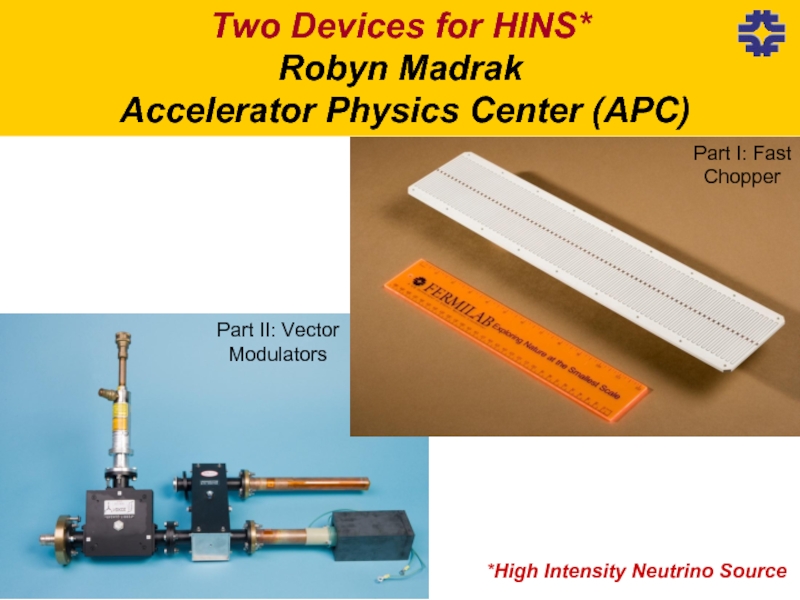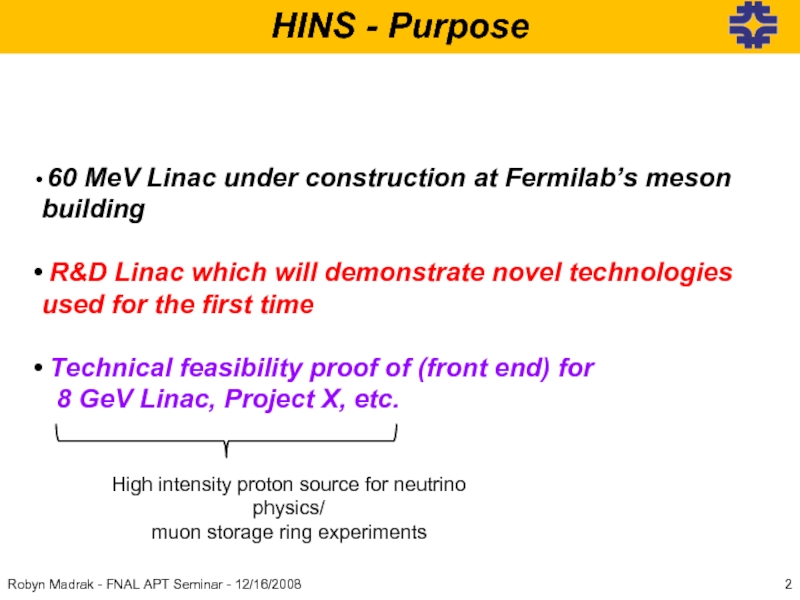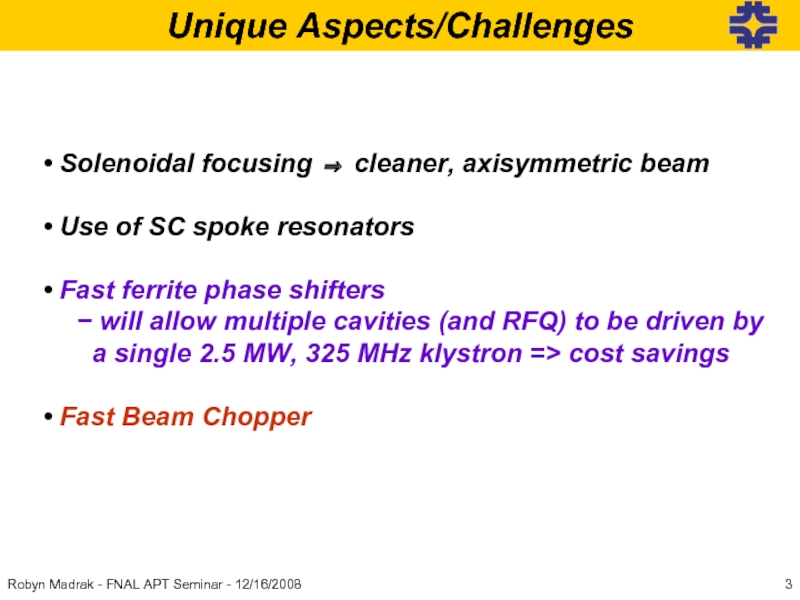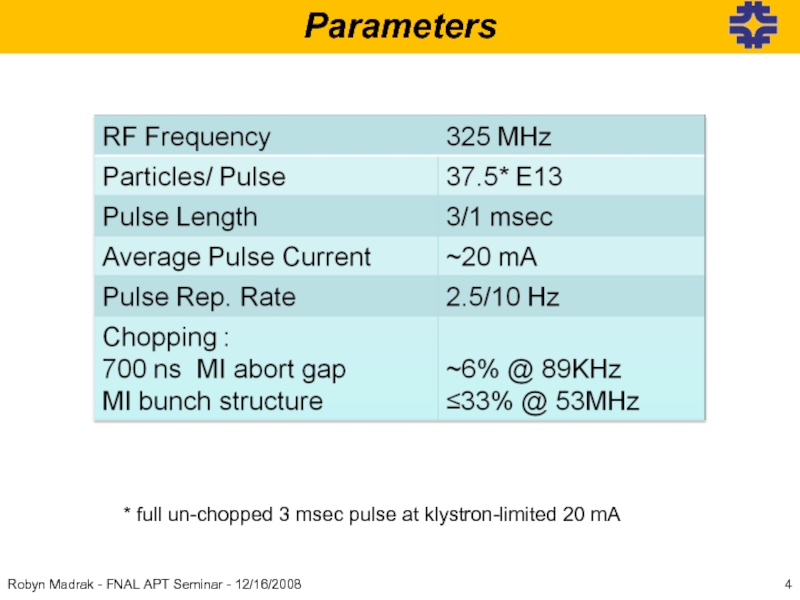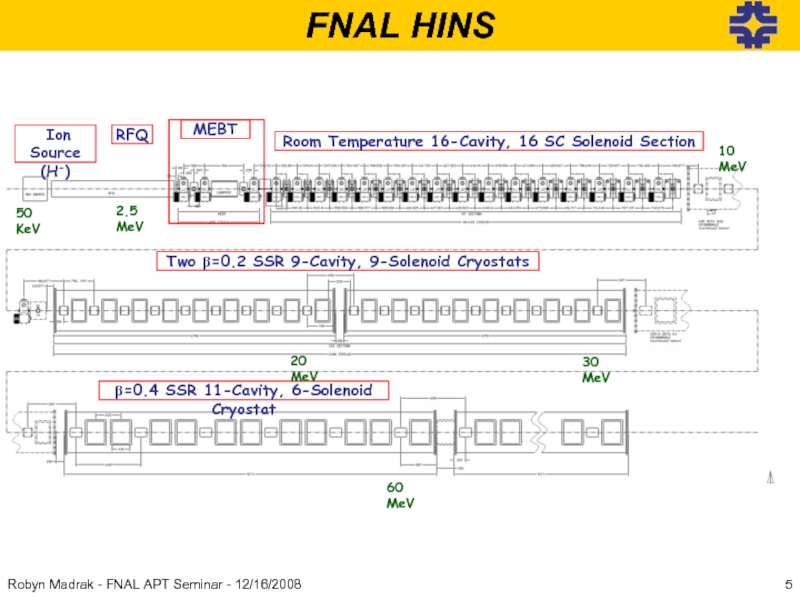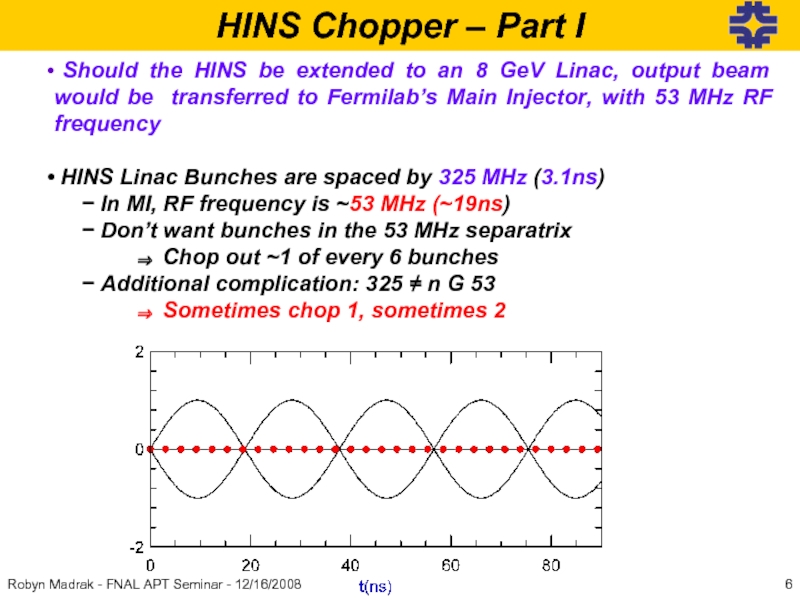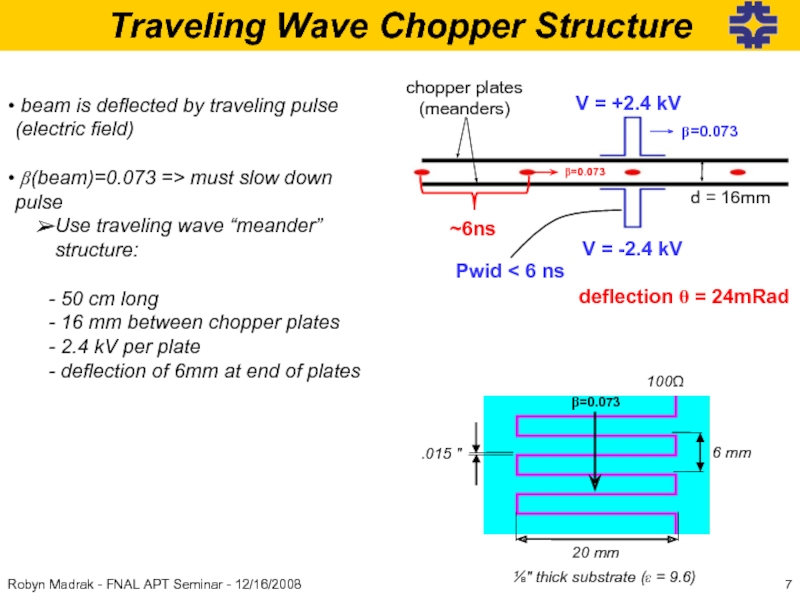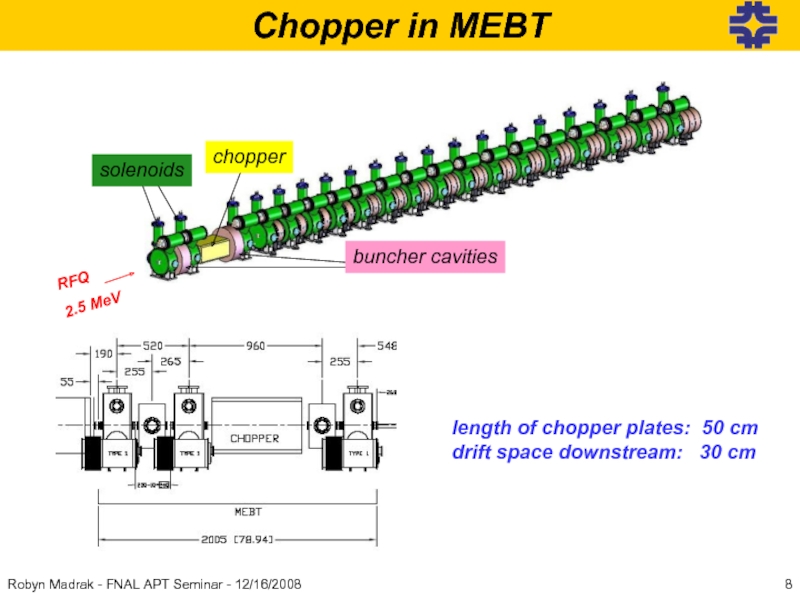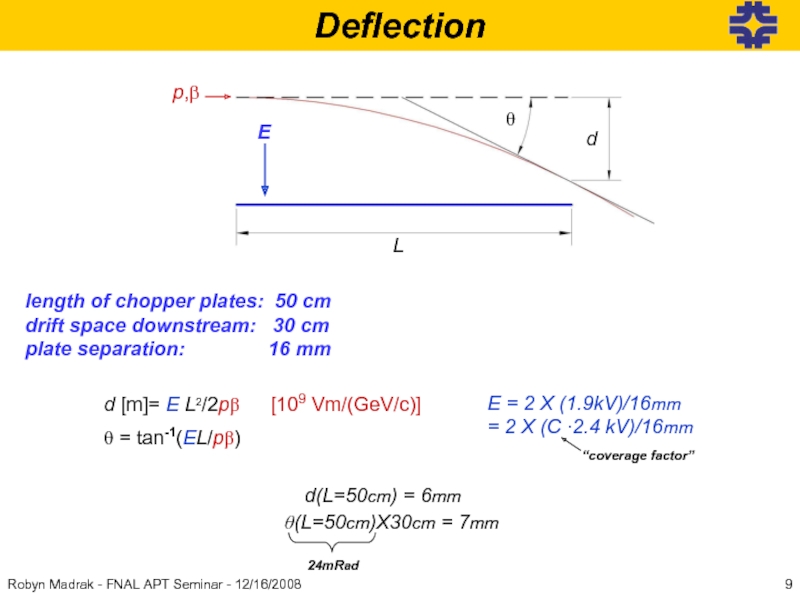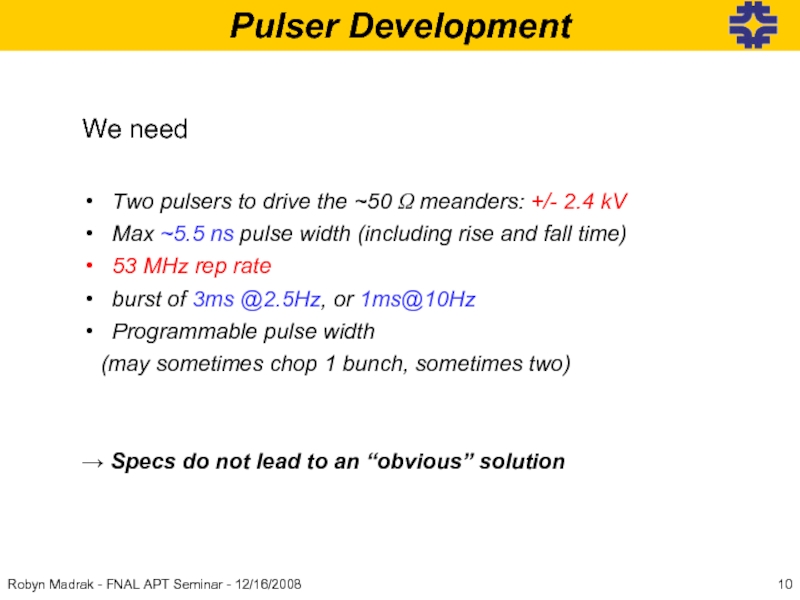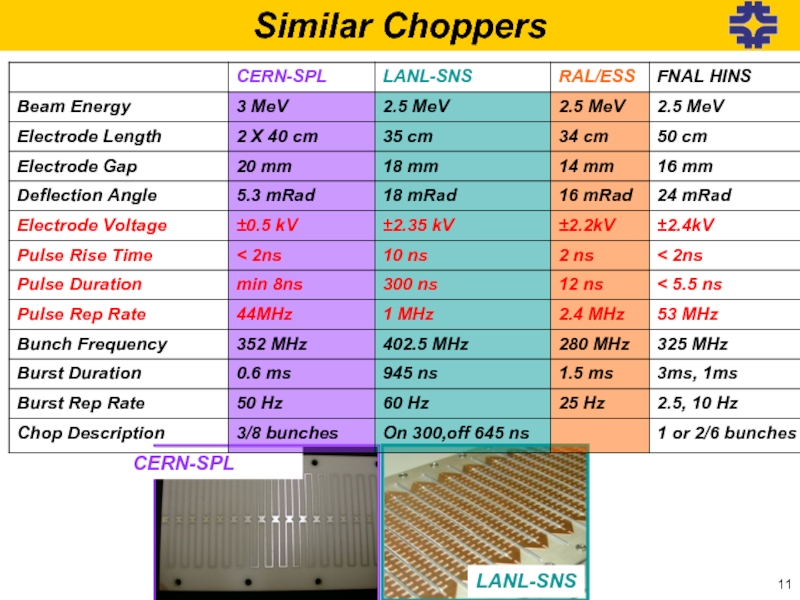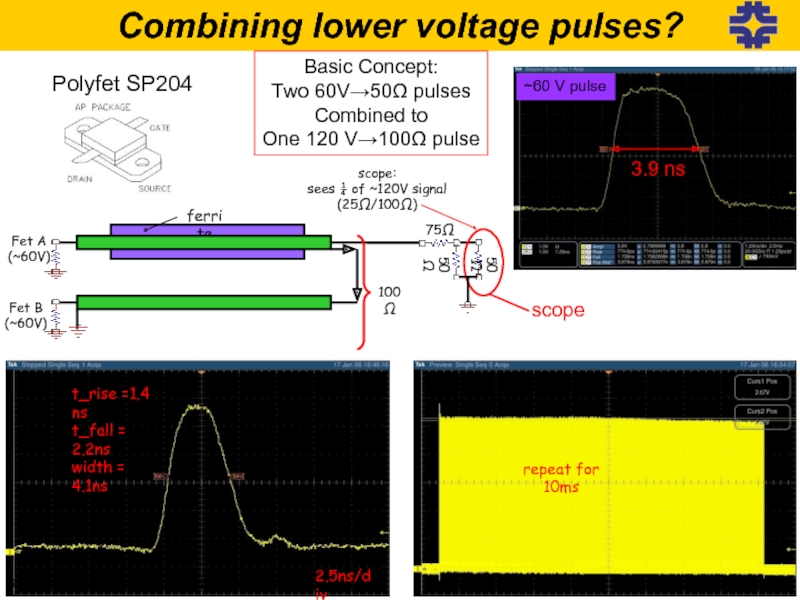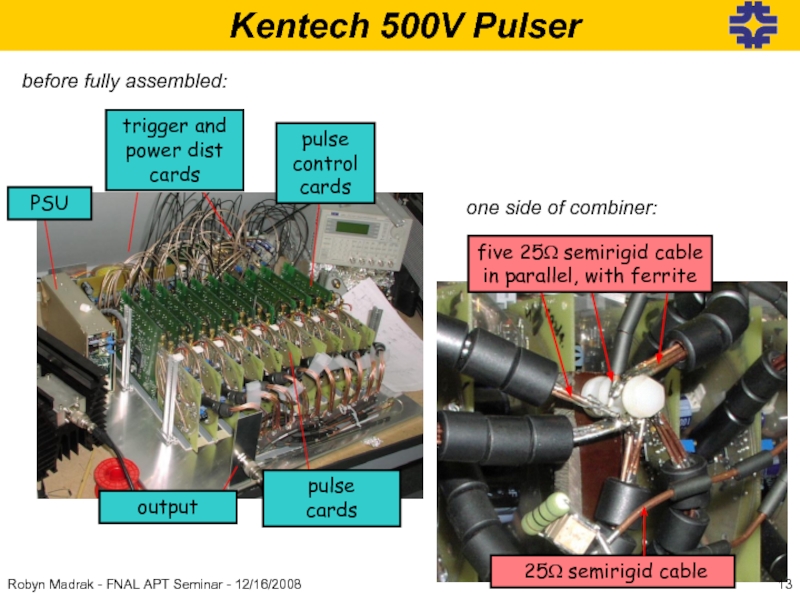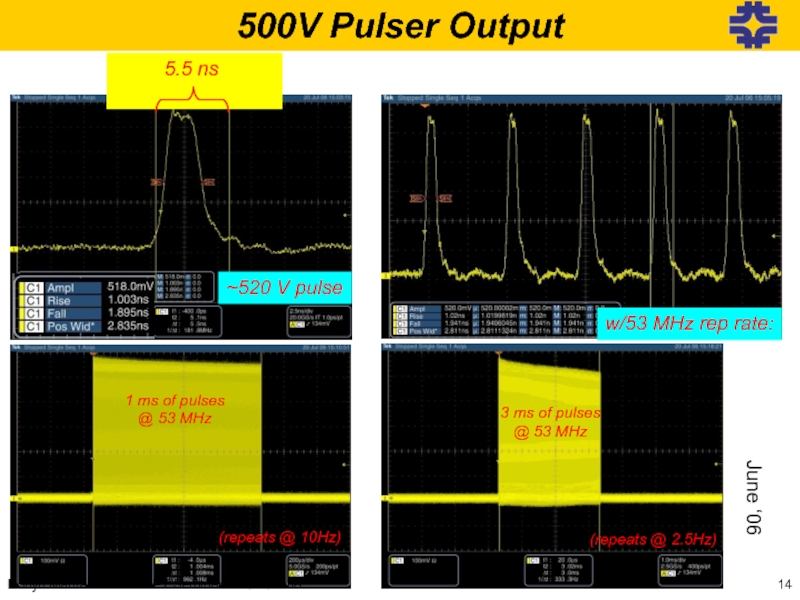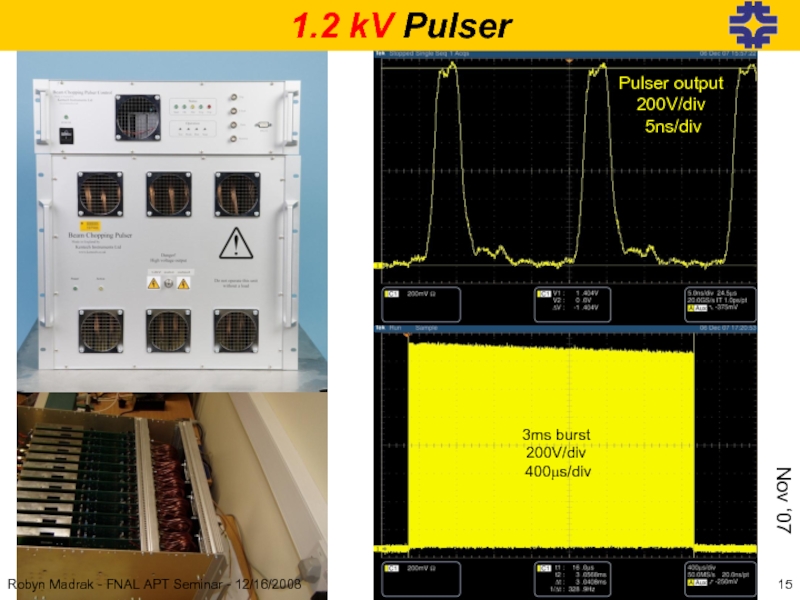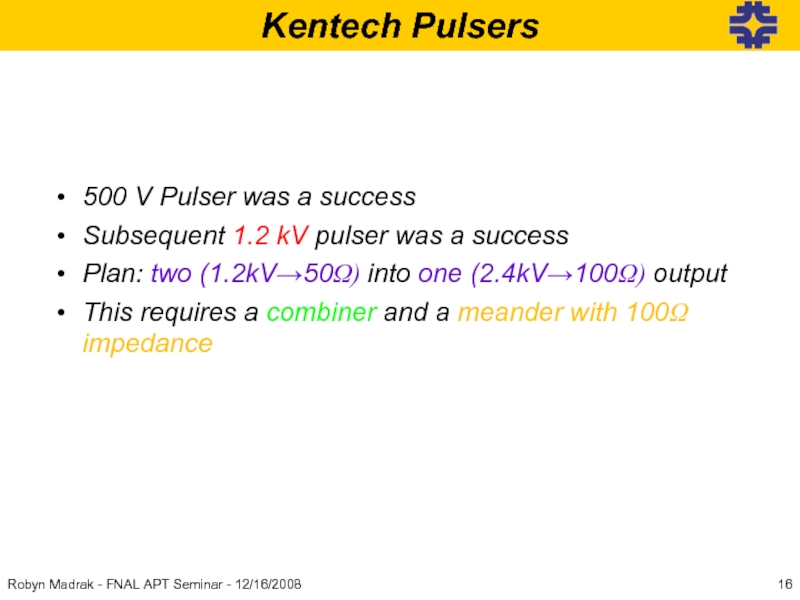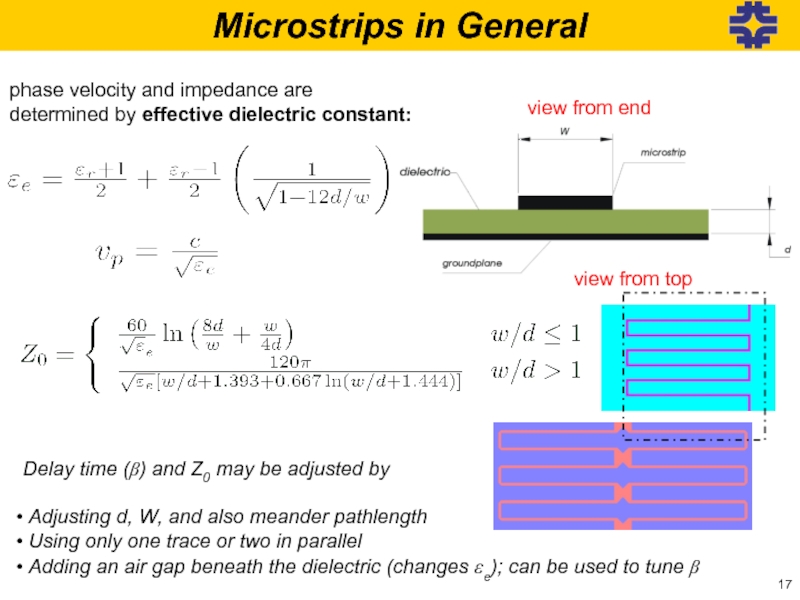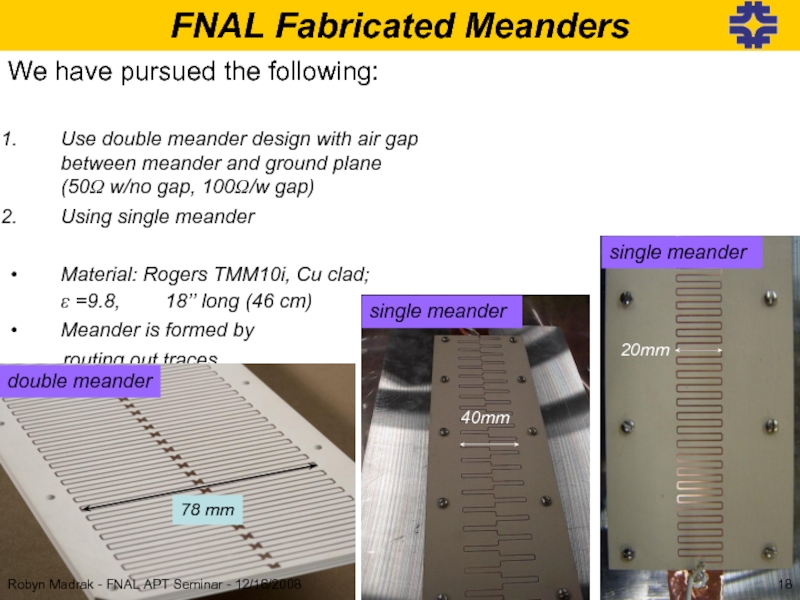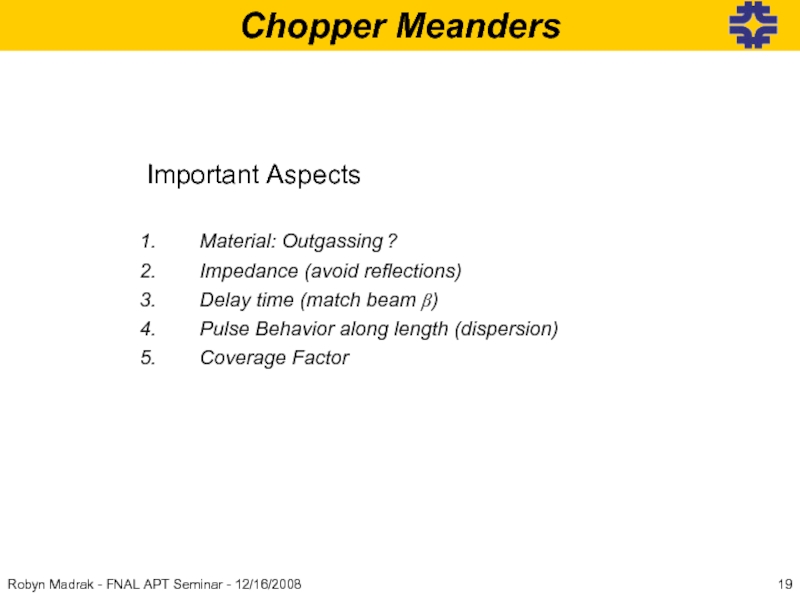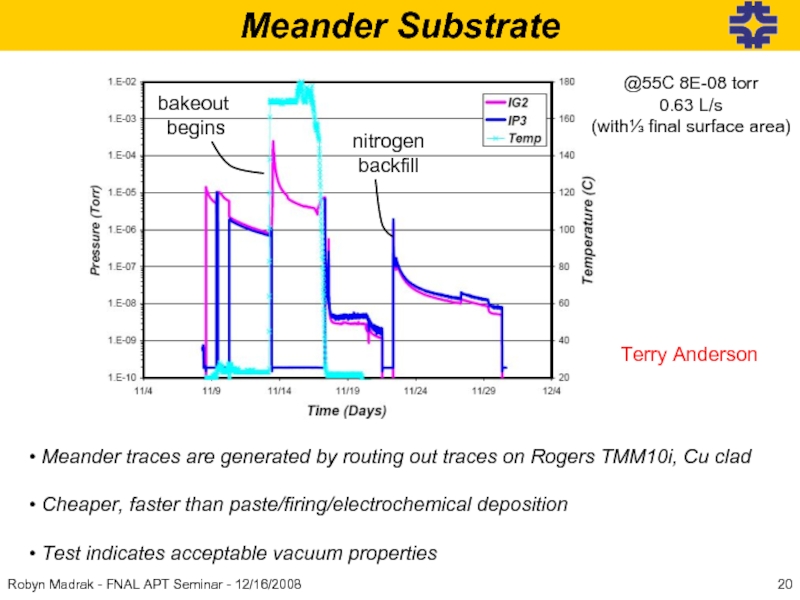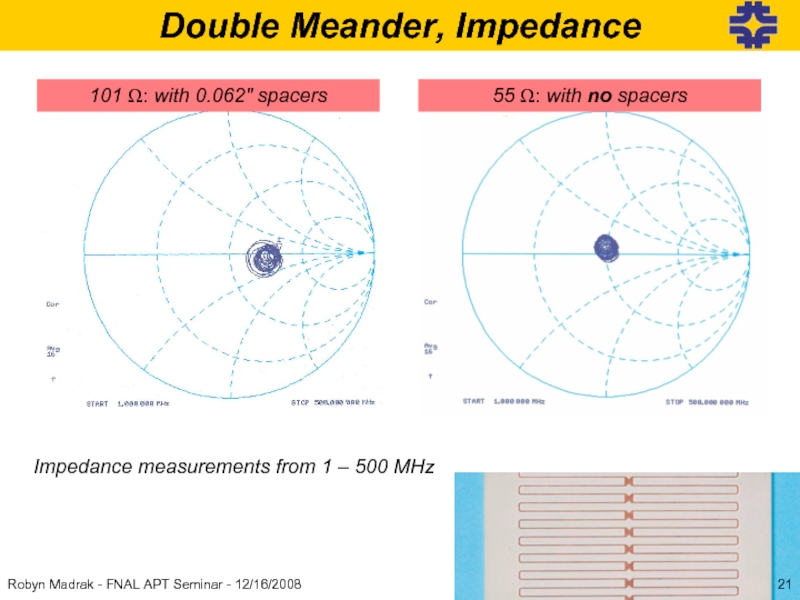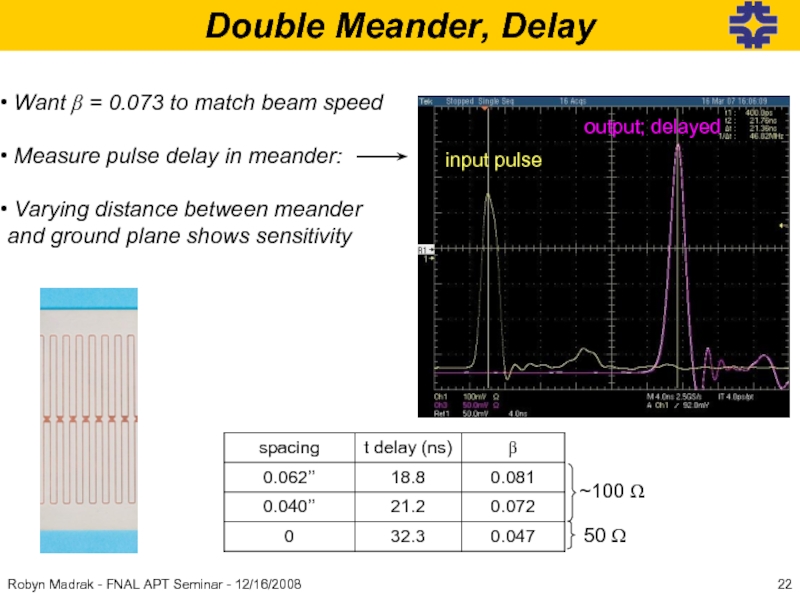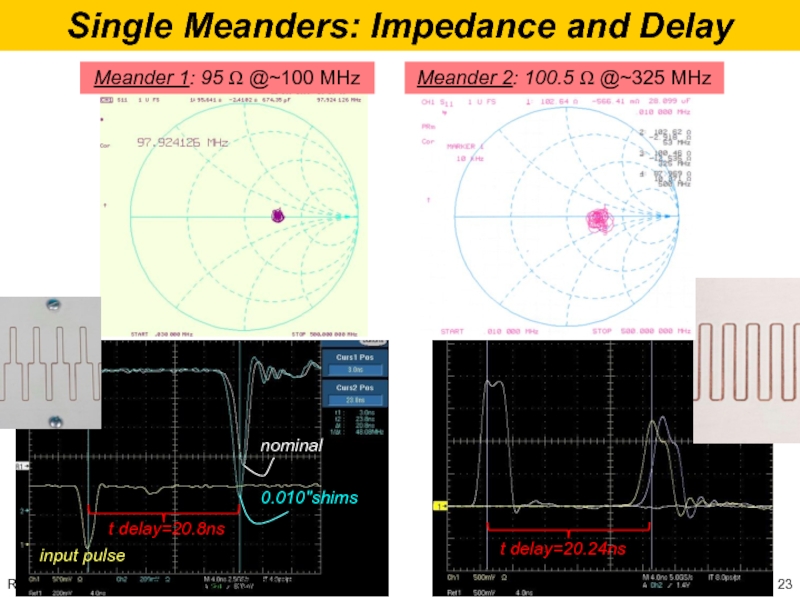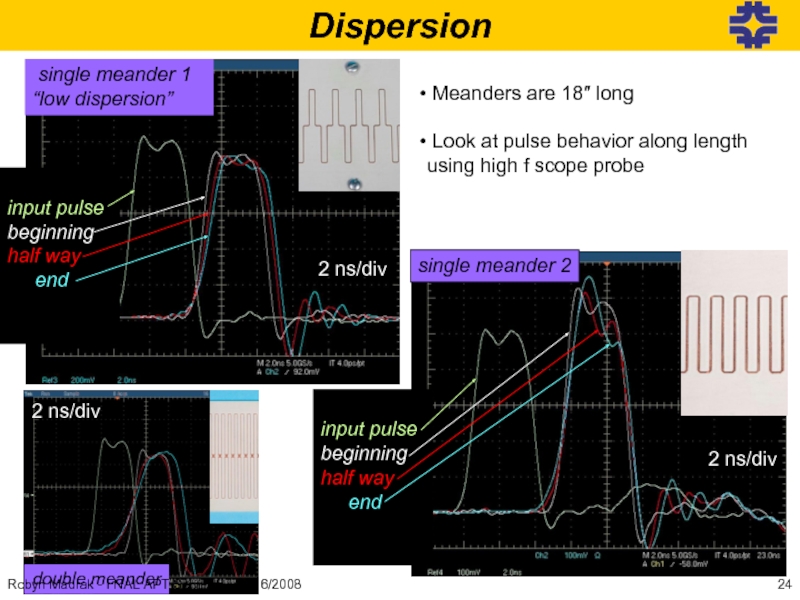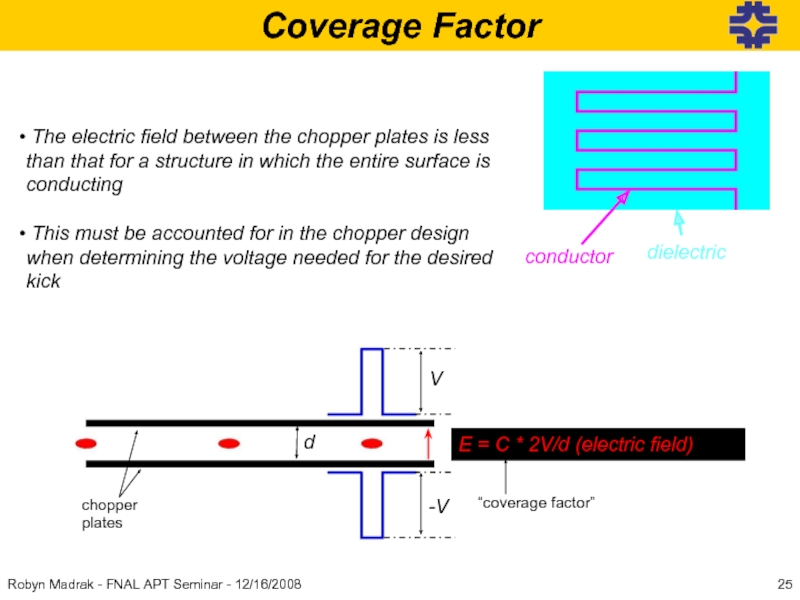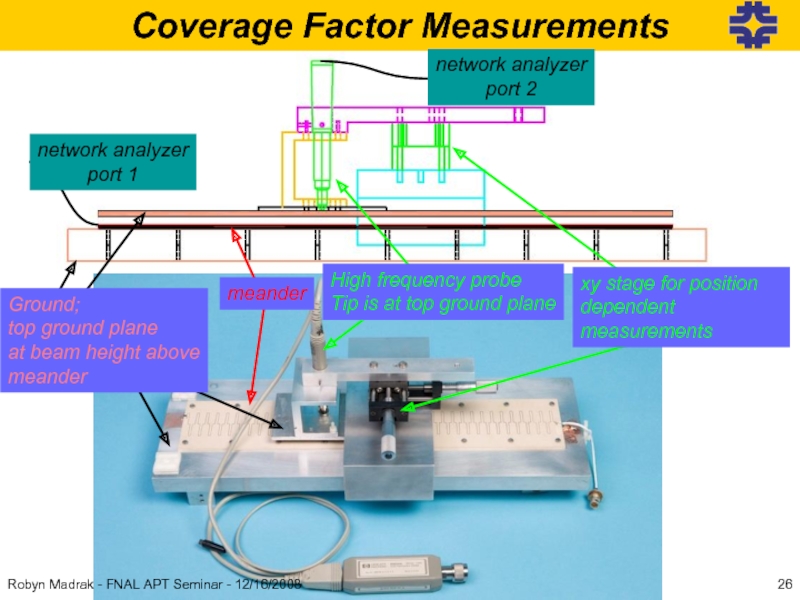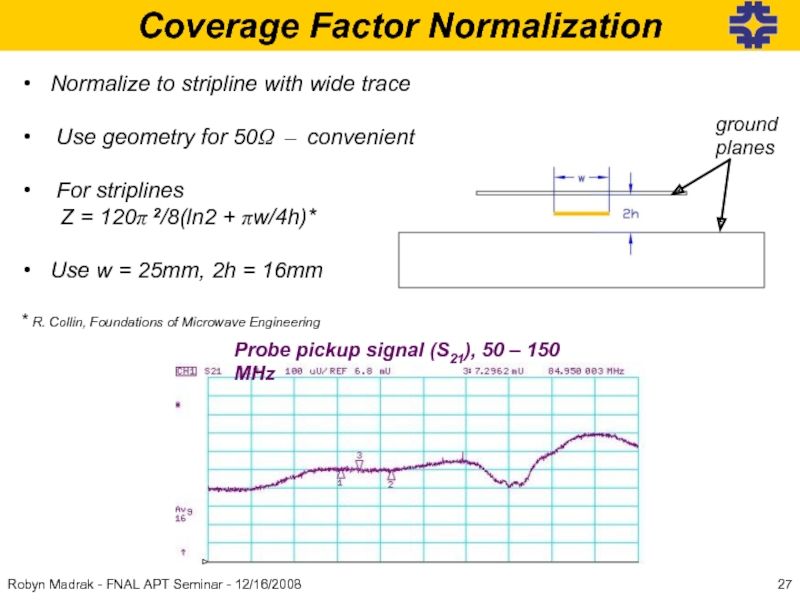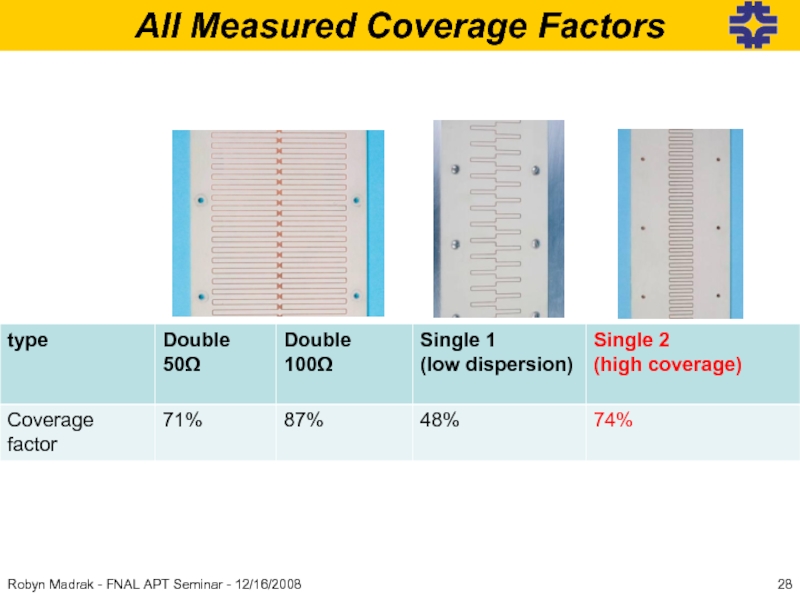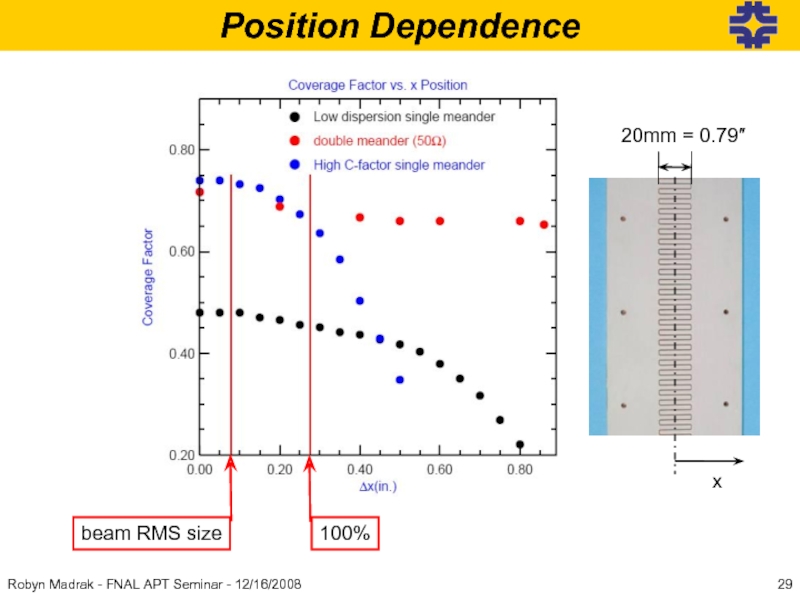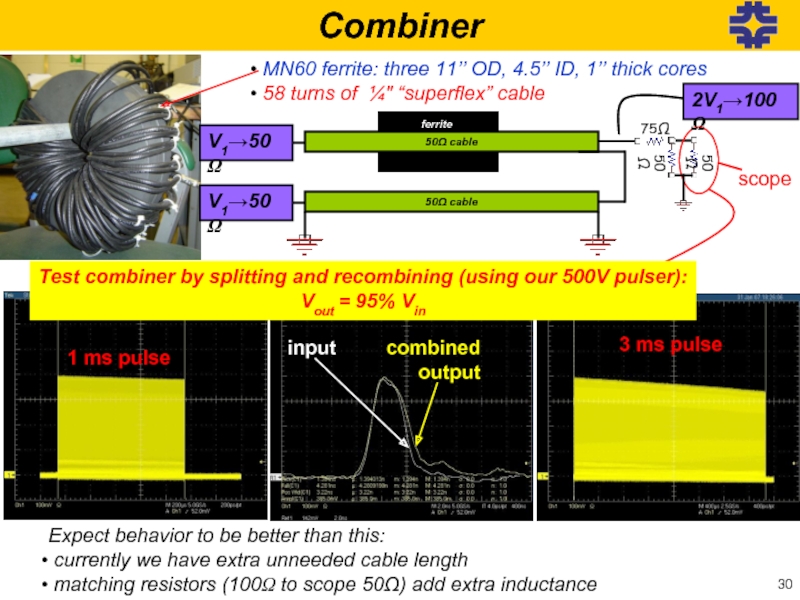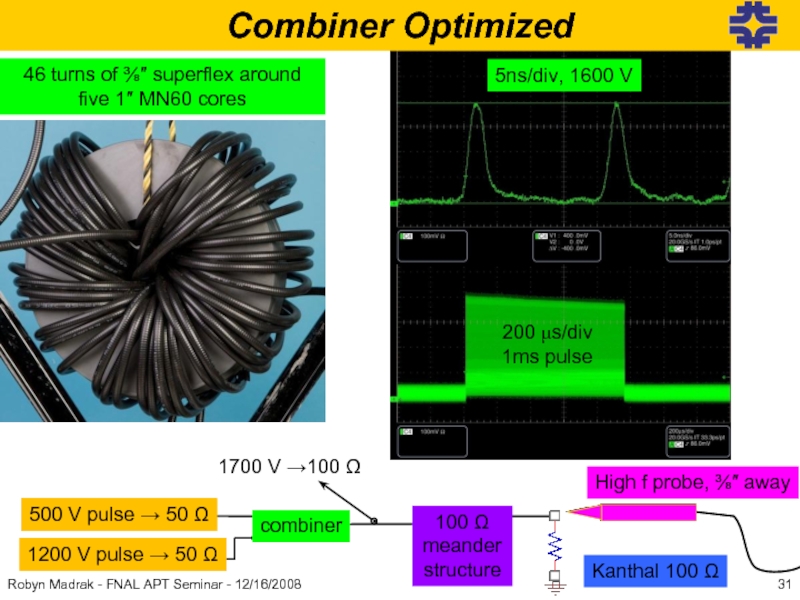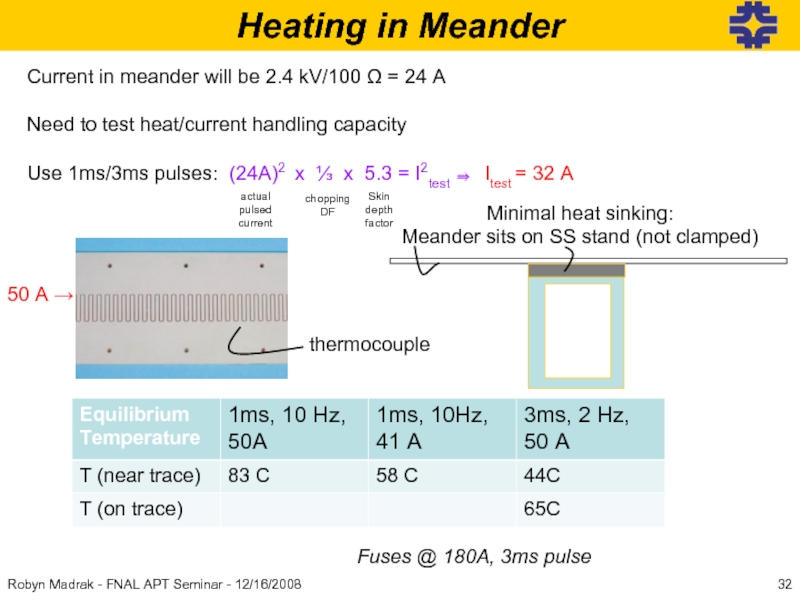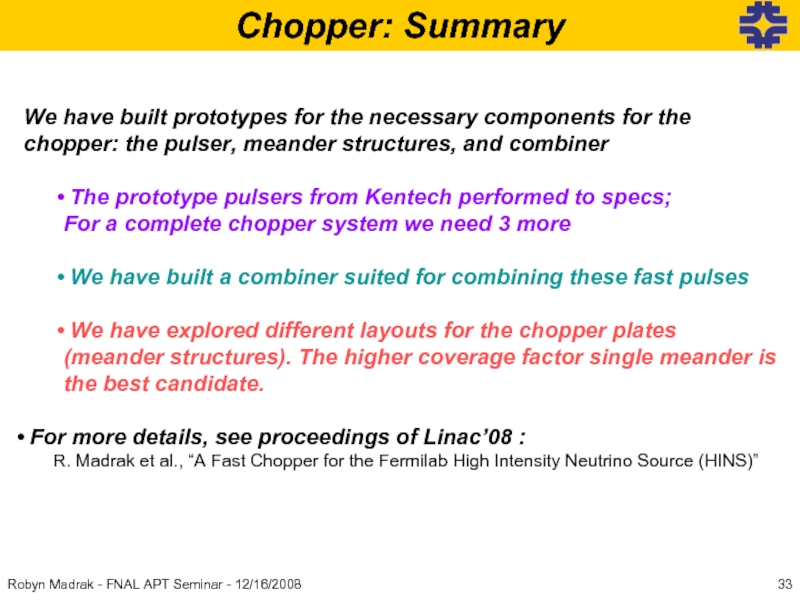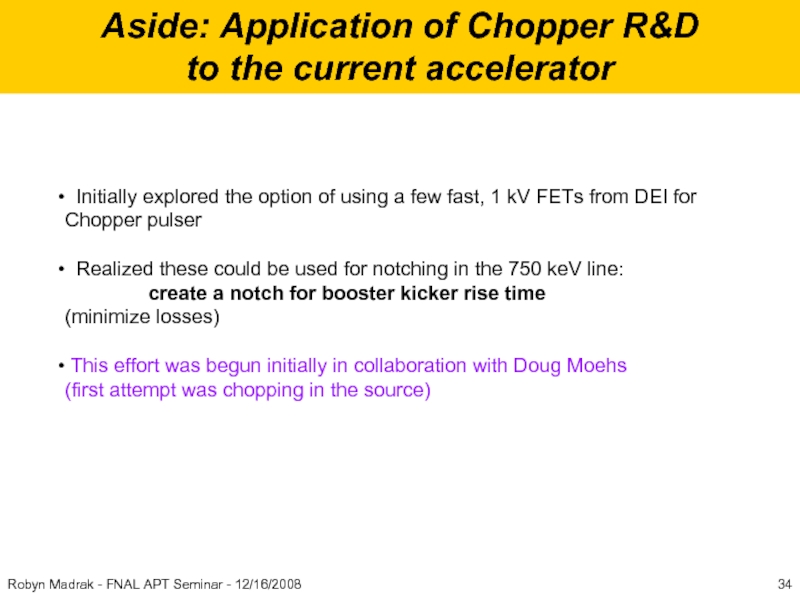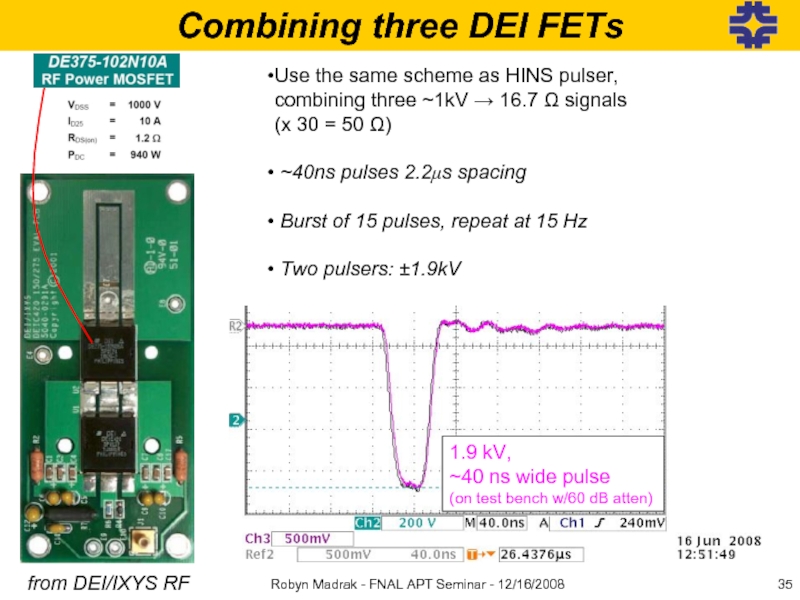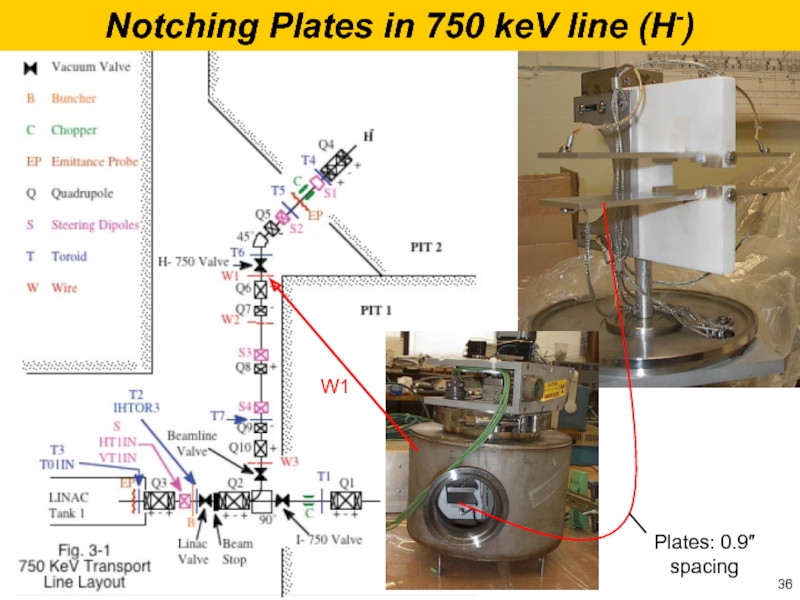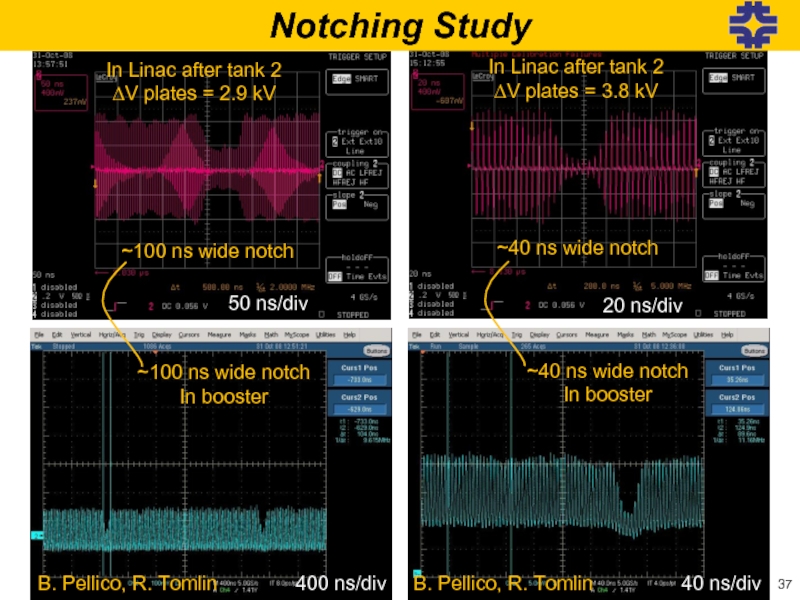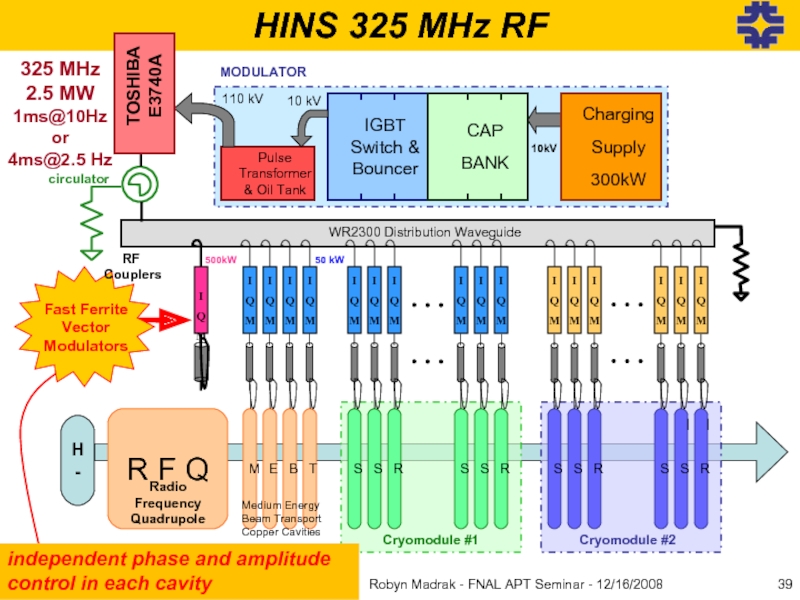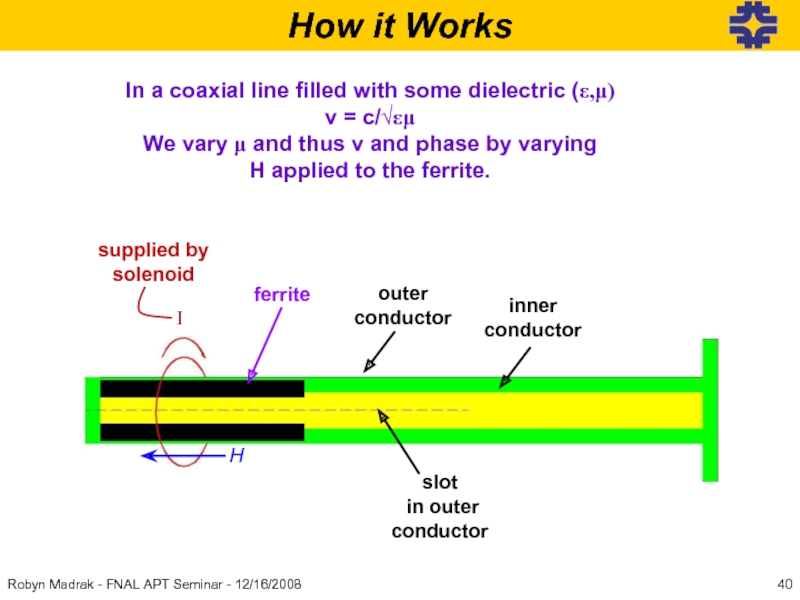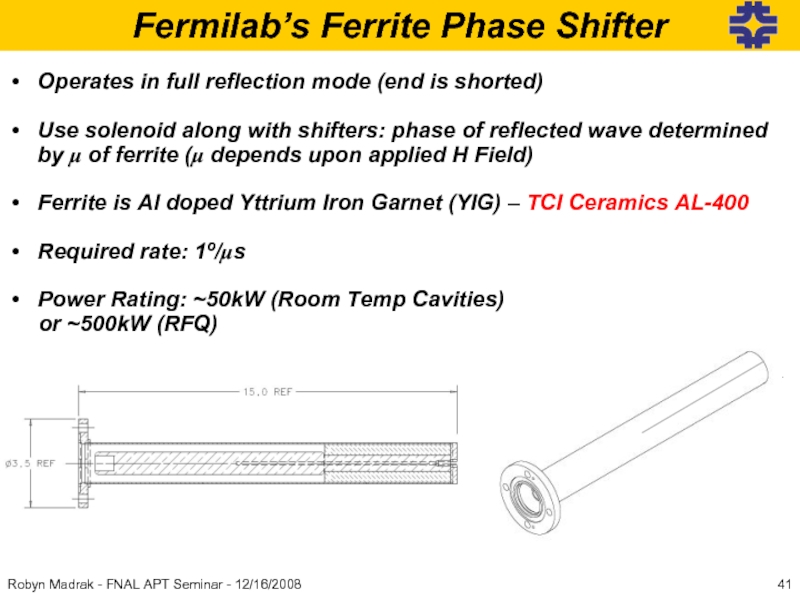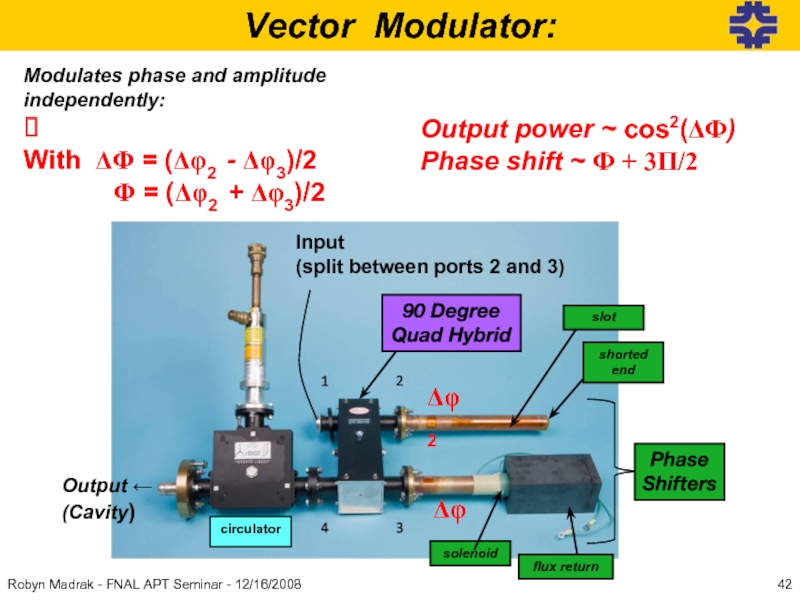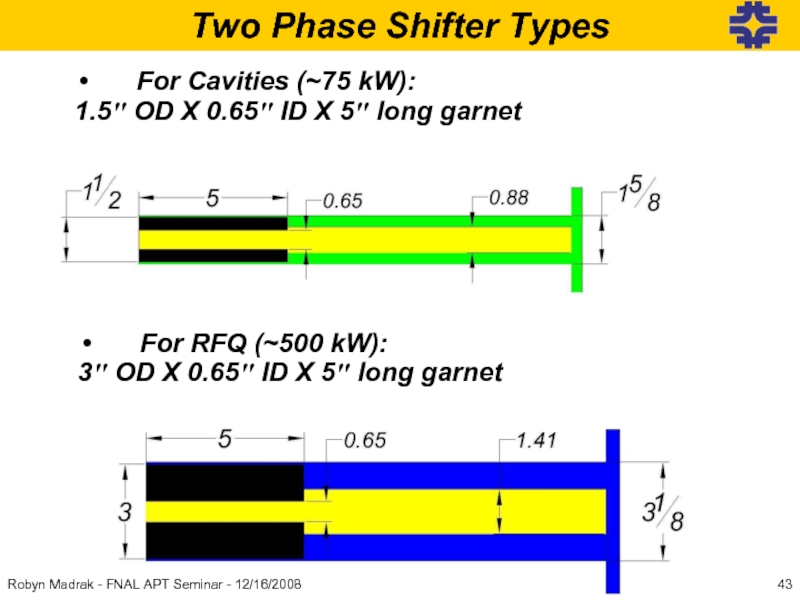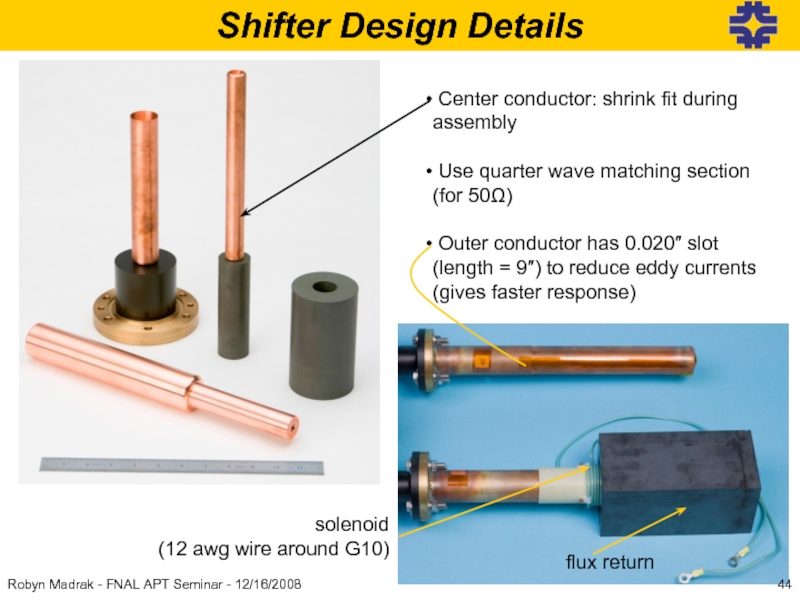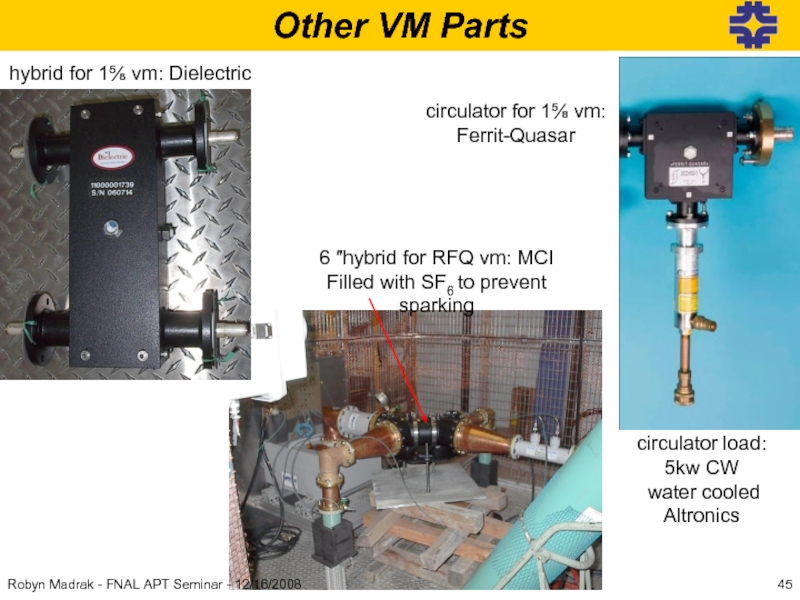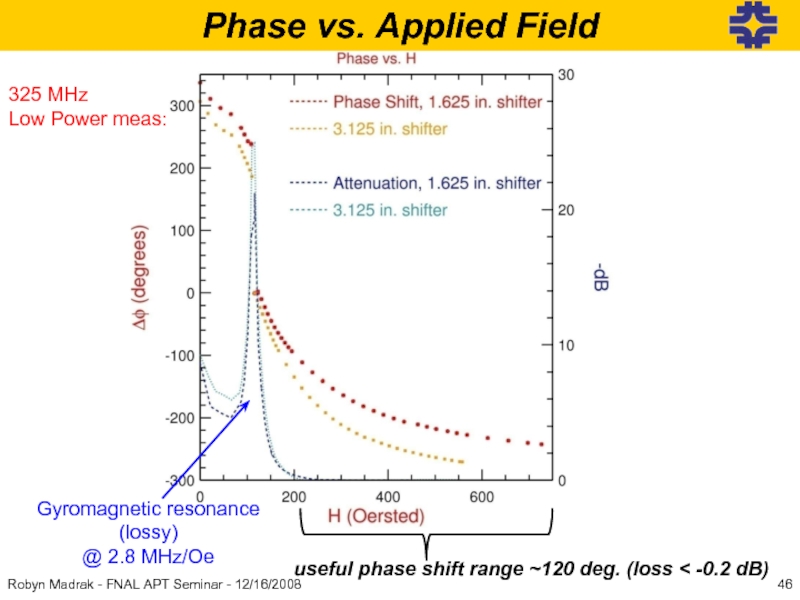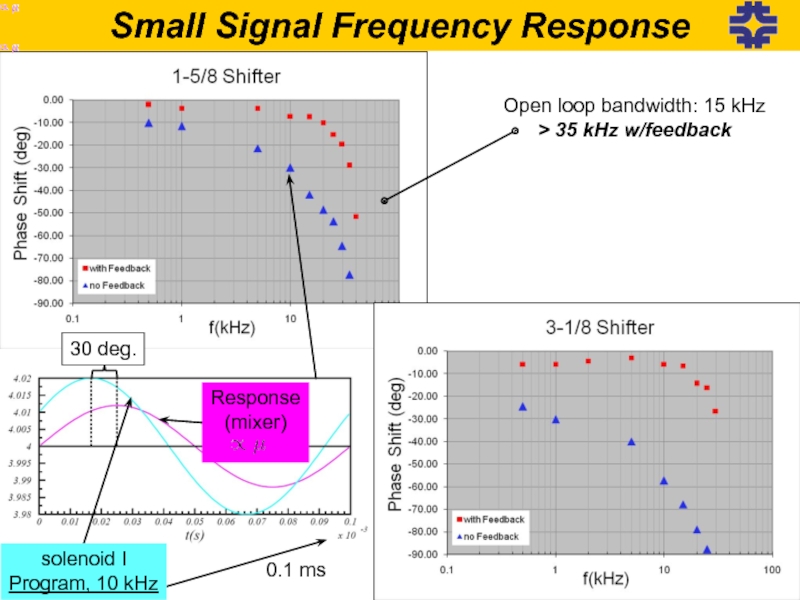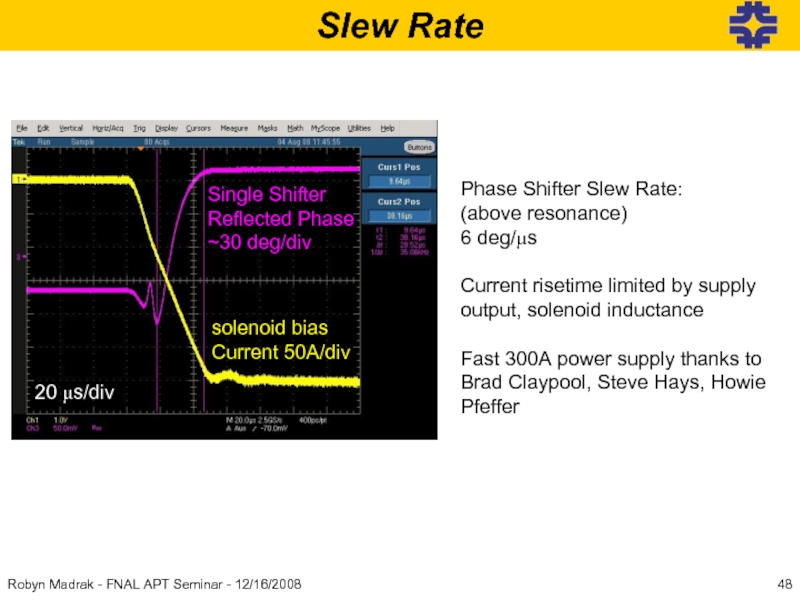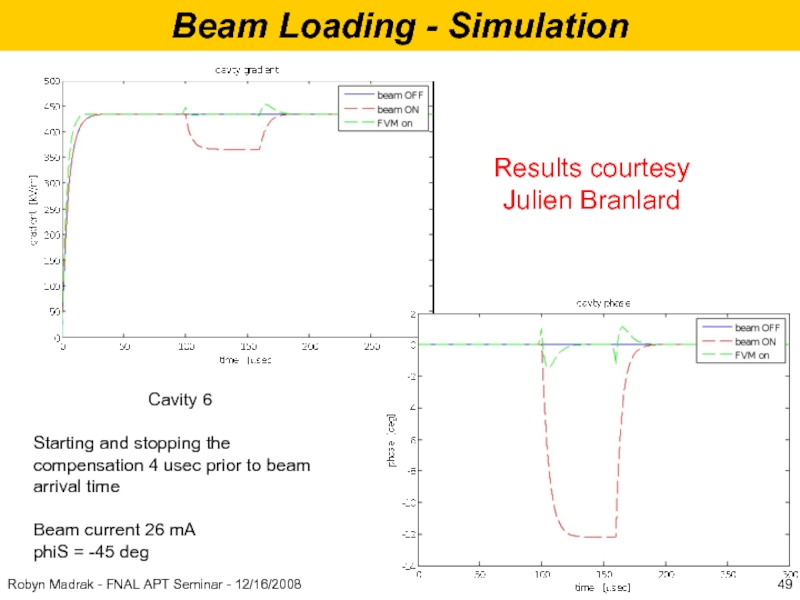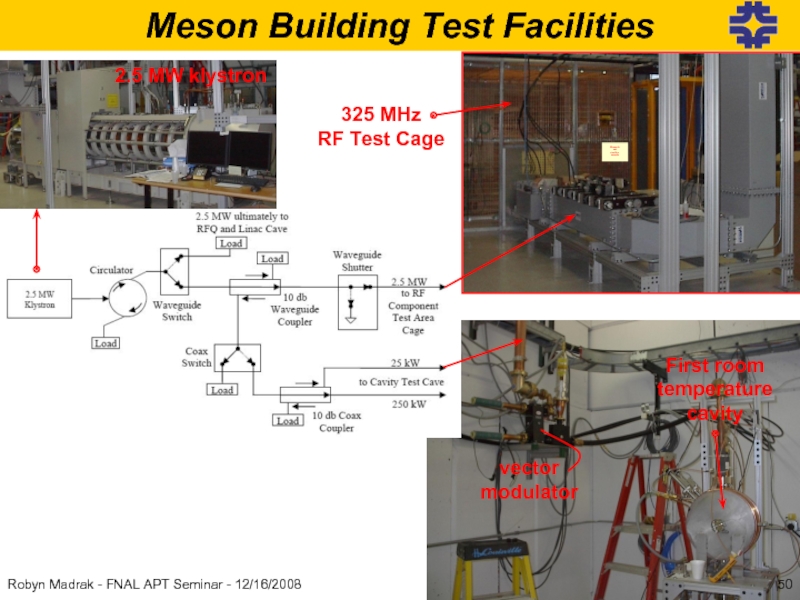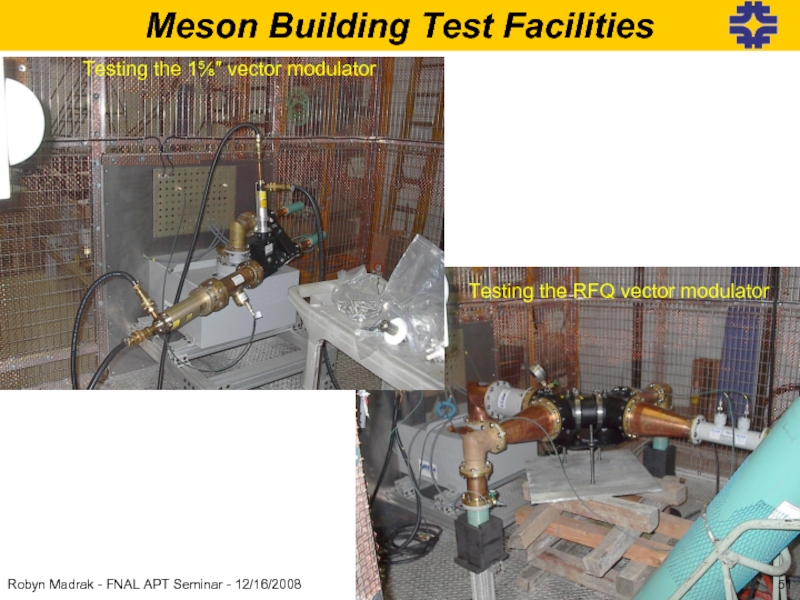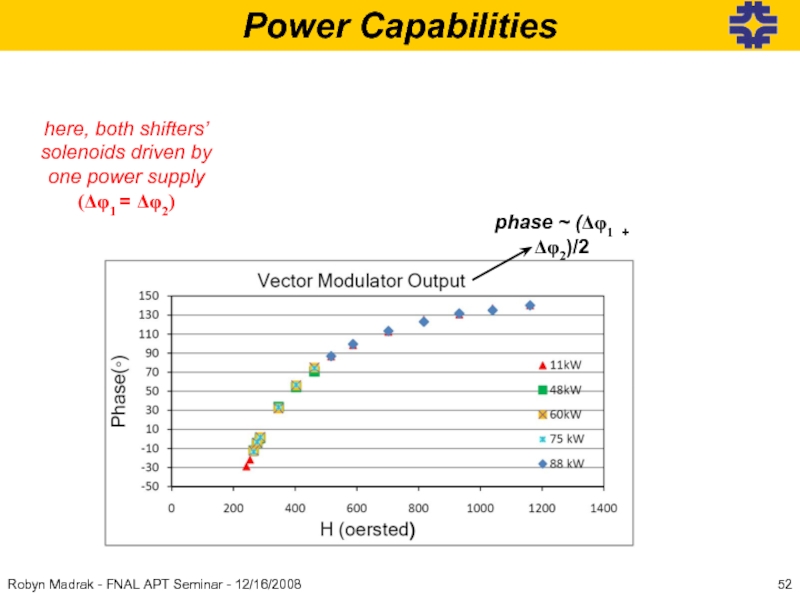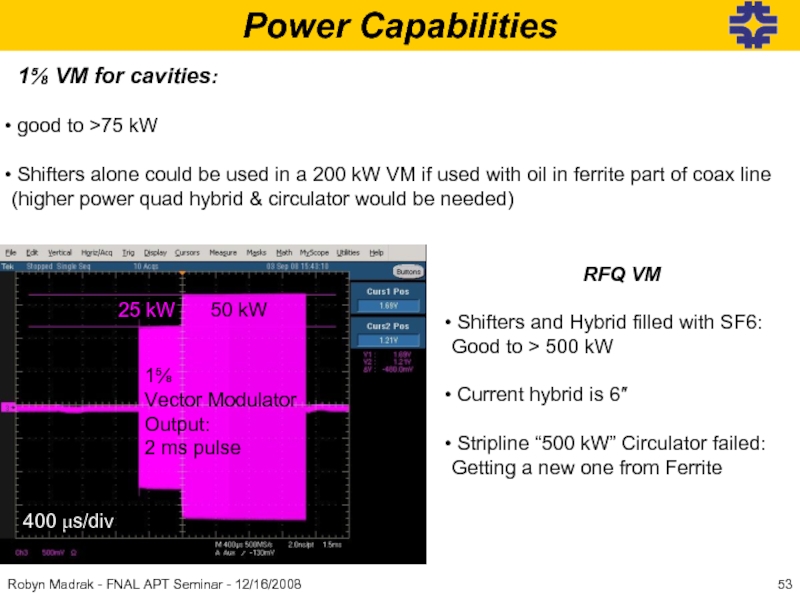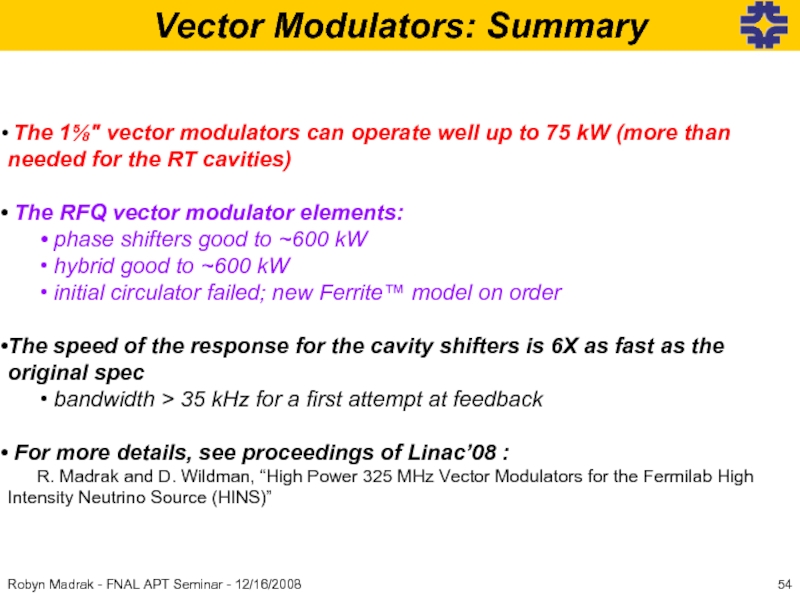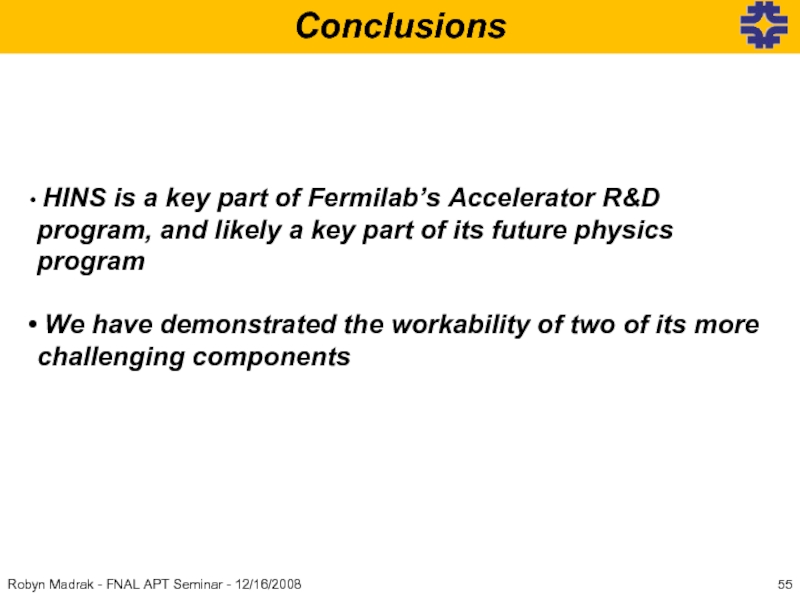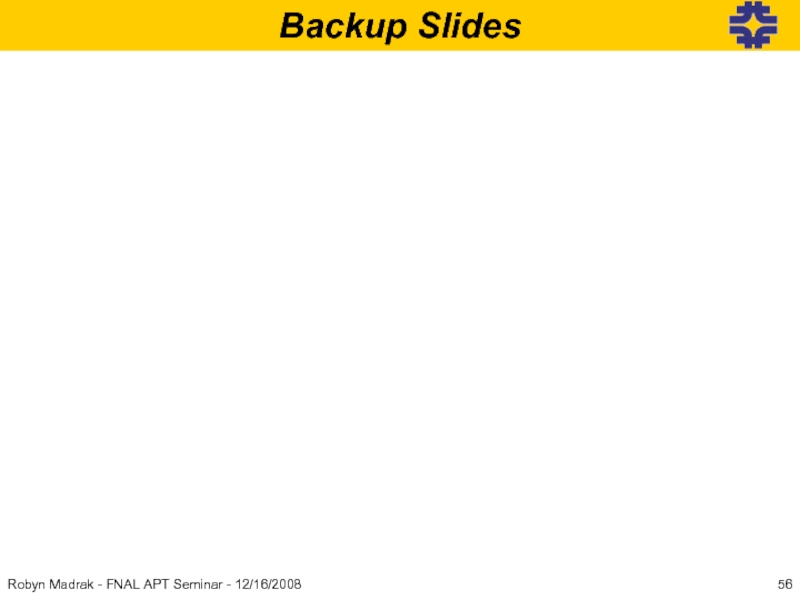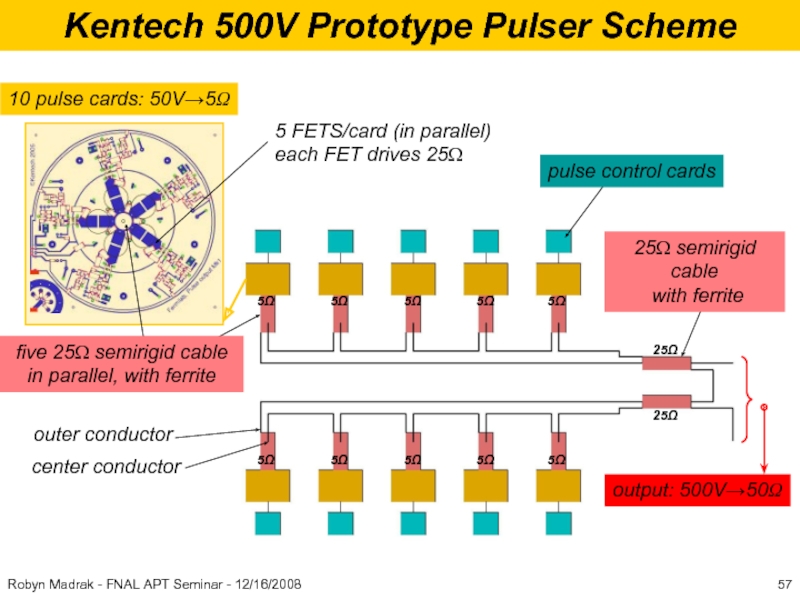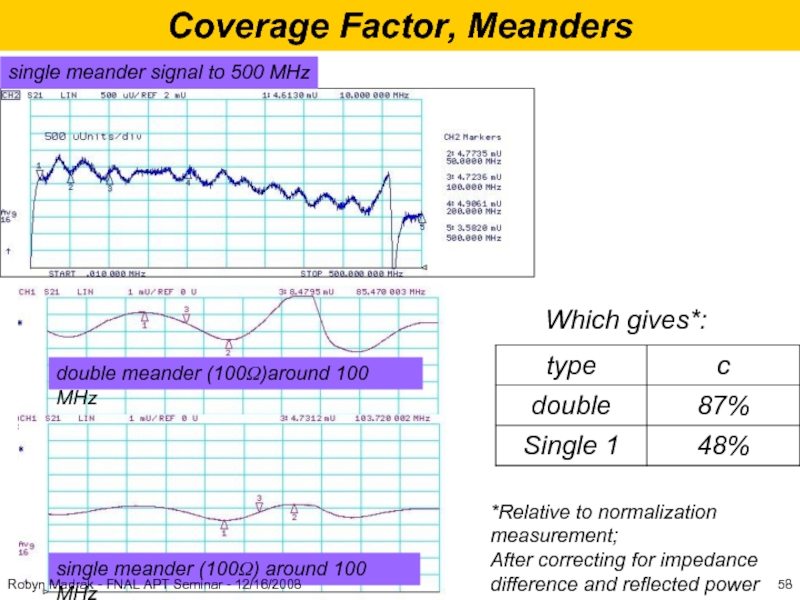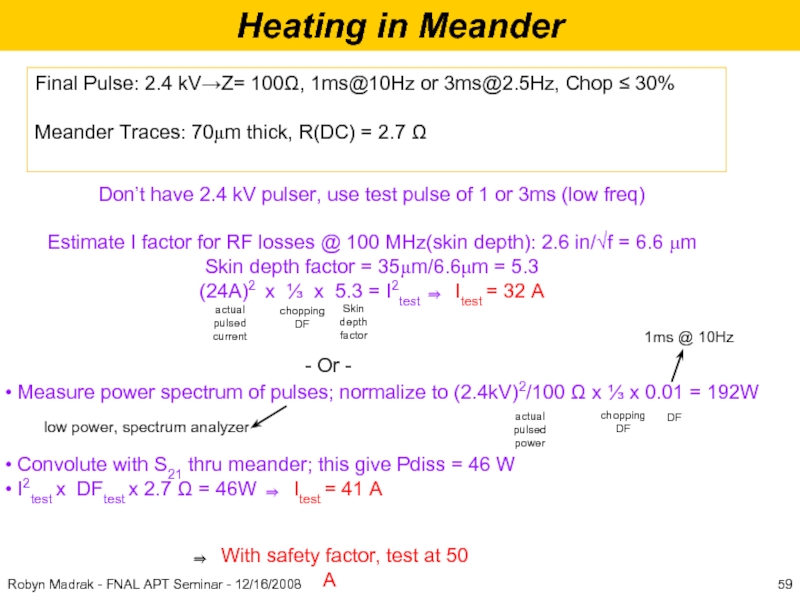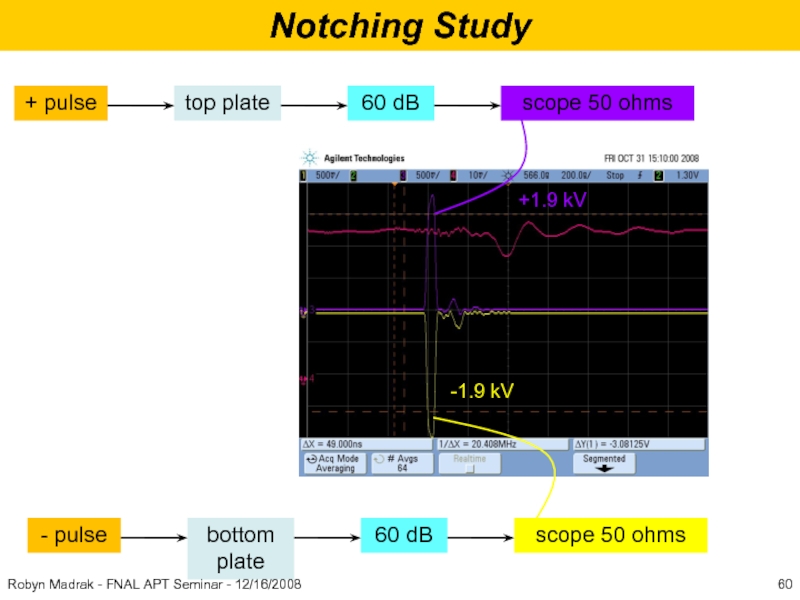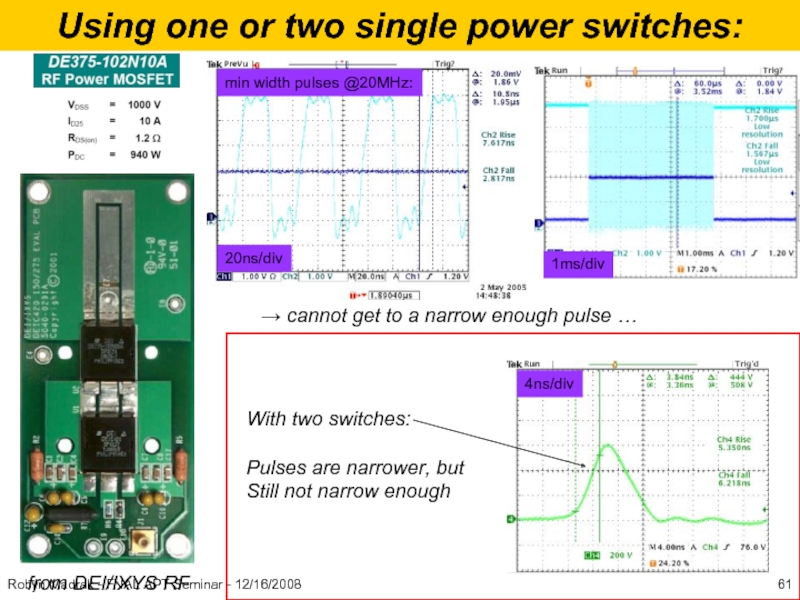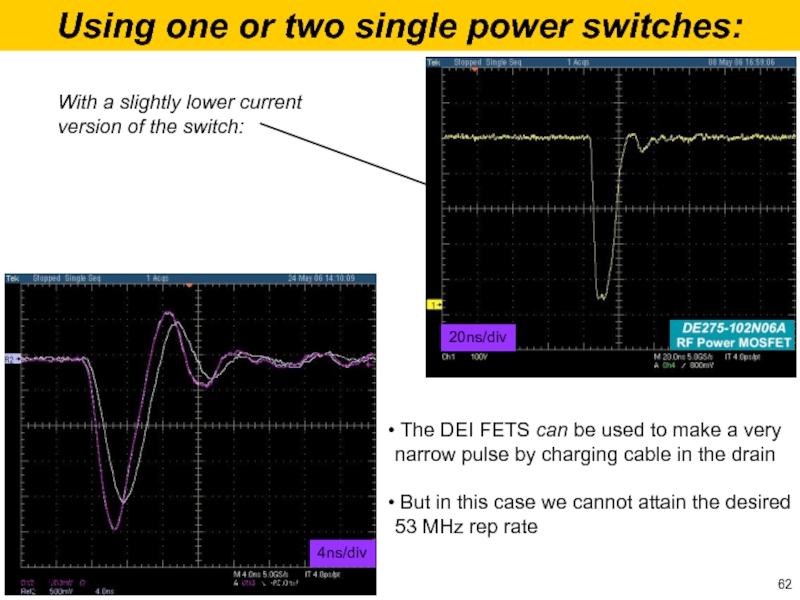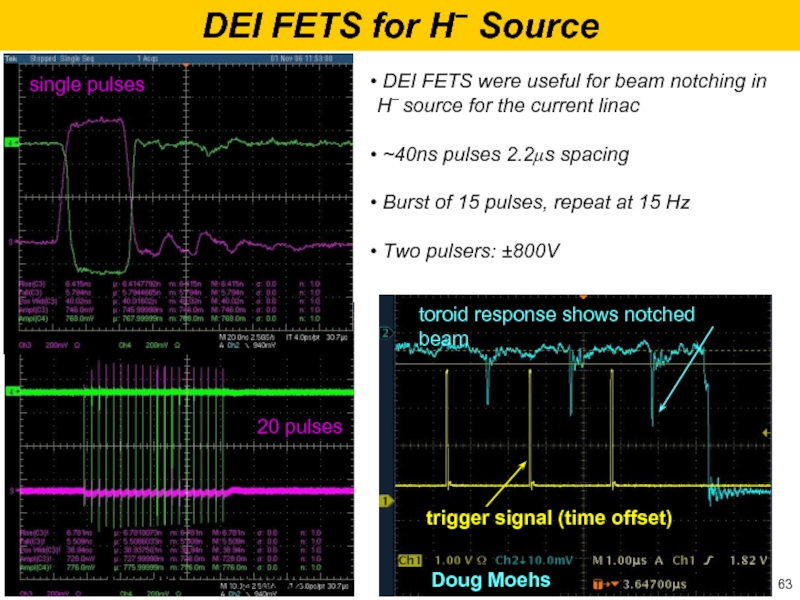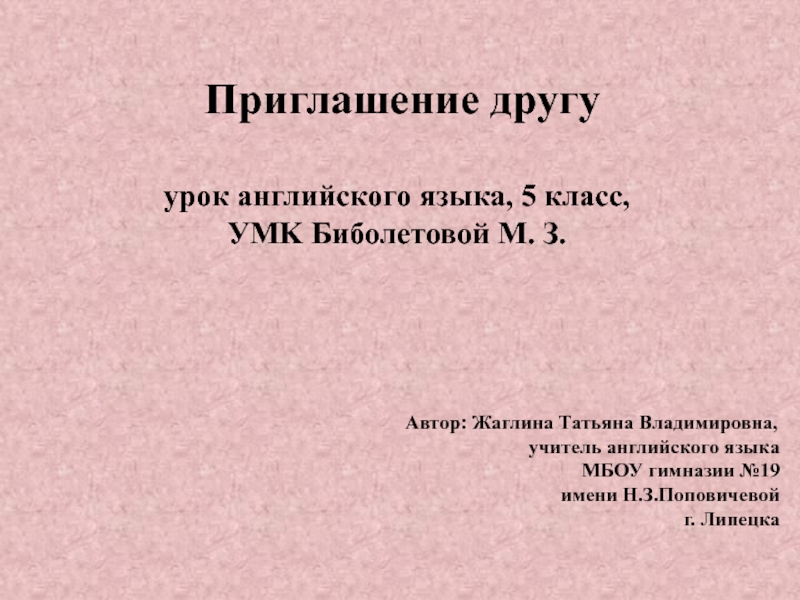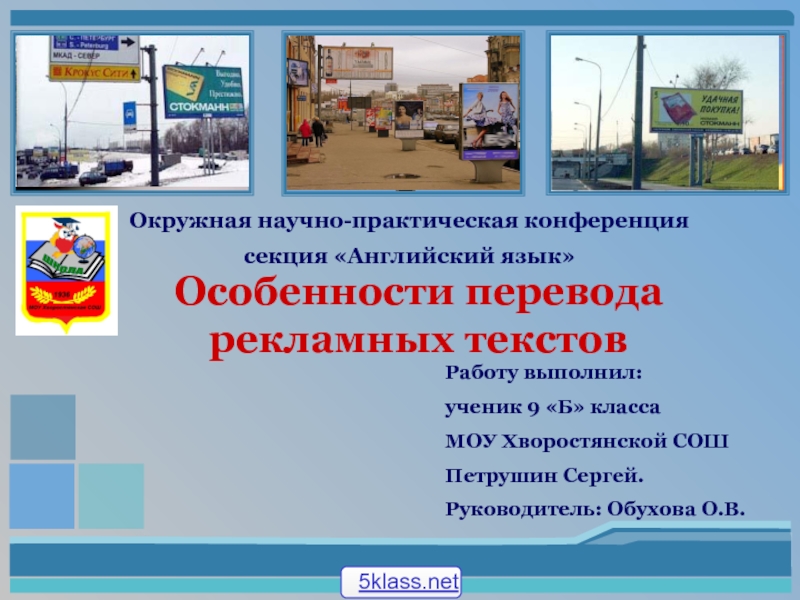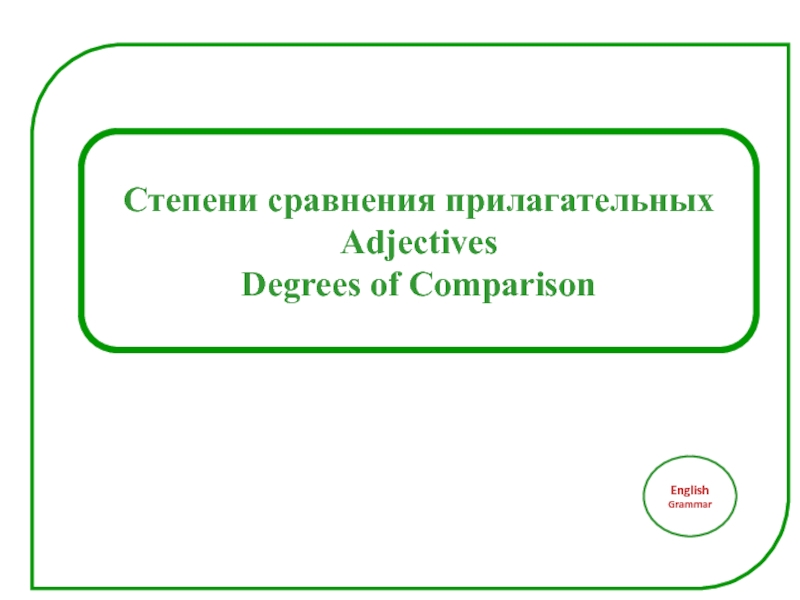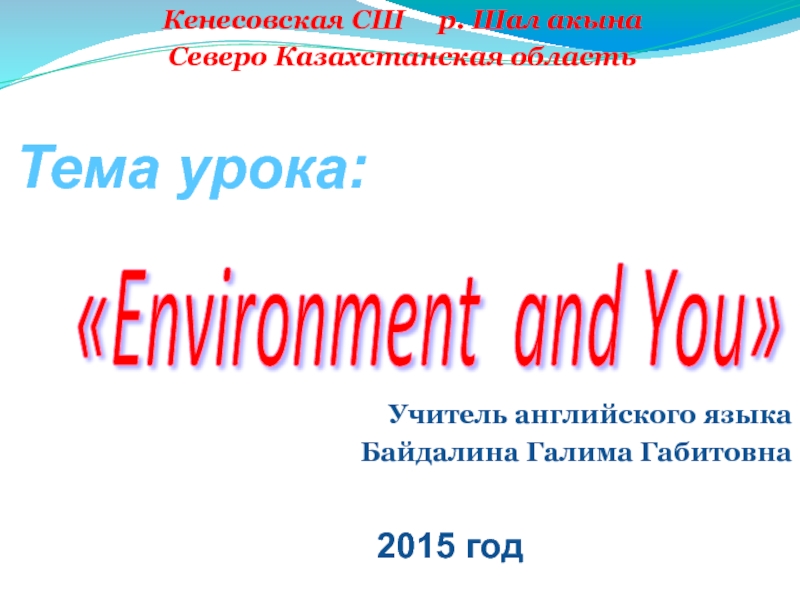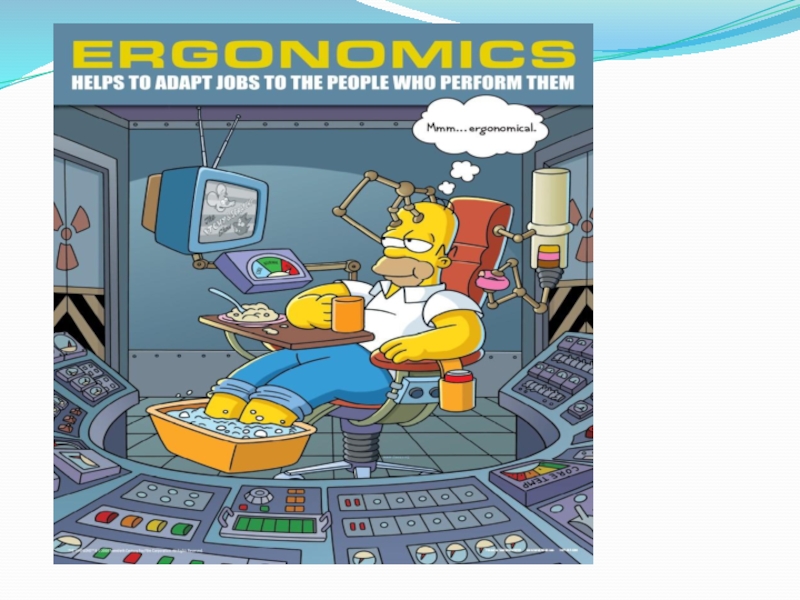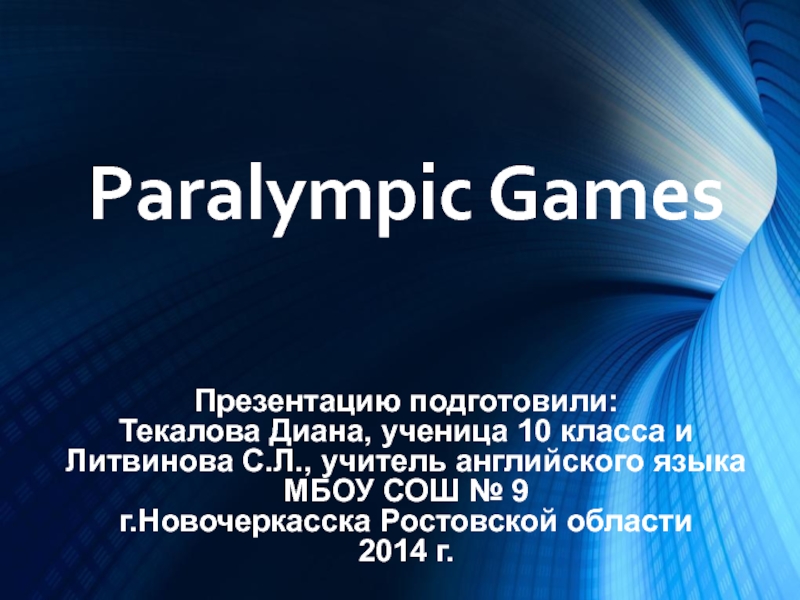Разделы презентаций
- Разное
- Английский язык
- Астрономия
- Алгебра
- Биология
- География
- Геометрия
- Детские презентации
- Информатика
- История
- Литература
- Математика
- Медицина
- Менеджмент
- Музыка
- МХК
- Немецкий язык
- ОБЖ
- Обществознание
- Окружающий мир
- Педагогика
- Русский язык
- Технология
- Физика
- Философия
- Химия
- Шаблоны, картинки для презентаций
- Экология
- Экономика
- Юриспруденция
Two Devices for HINS Robyn Madrak Accelerator Physics Center (APC)
Содержание
- 1. Two Devices for HINS Robyn Madrak Accelerator Physics Center (APC)
- 2. HINS - PurposeRobyn Madrak - FNAL APT
- 3. Unique Aspects/Challenges Solenoidal focusing cleaner, axisymmetric
- 4. Robyn Madrak - FNAL APT Seminar -
- 5. FNAL HINSRobyn Madrak - FNAL APT Seminar - 12/16/2008
- 6. HINS Chopper – Part I Should the
- 7. Traveling Wave Chopper Structure beam is deflected
- 8. Chopper in MEBTlength of chopper plates: 50
- 9. Deflectionlength of chopper plates: 50 cmdrift space
- 10. Pulser DevelopmentRobyn Madrak - FNAL APT Seminar
- 11. Similar ChoppersCERN-SPLLANL-SNS
- 12. Combining lower voltage pulses?scope:sees ¼ of ~120V
- 13. Kentech 500V Pulserpulsecontrol cardsPSUpulsecardstrigger and power
- 14. ~520 V pulse
- 15. Pulser output200V/div 5ns/div3ms burst200V/div 400ms/div1.2 kV PulserNov ‘07Robyn Madrak - FNAL APT Seminar - 12/16/2008
- 16. Kentech Pulsers500 V Pulser was a successSubsequent
- 17. Microstrips in Generalphase velocity and impedance aredetermined
- 18. FNAL Fabricated MeandersWe have pursued the following:Use
- 19. Chopper MeandersImportant AspectsMaterial: Outgassing ?Impedance (avoid reflections)Delay time
- 20. Meander Substrate Meander traces are generated by
- 21. Double Meander, ImpedanceImpedance measurements from 1 – 500 MHzRobyn Madrak - FNAL APT Seminar - 12/16/2008
- 22. Double Meander, DelayRobyn Madrak - FNAL APT
- 23. Single Meanders: Impedance and DelayMeander 1: 95
- 24. Dispersioninput pulse beginninghalf way
- 25. Coverage Factor The electric field between the
- 26. Coverage Factor MeasurementsHigh frequency probeTip is at
- 27. input pulse@ end@endCoverage Factor NormalizationNormalize to stripline
- 28. All Measured Coverage FactorsRobyn Madrak - FNAL APT Seminar - 12/16/2008
- 29. Position Dependencebeam RMS size100%xRobyn Madrak - FNAL APT Seminar - 12/16/200820mm = 0.79″
- 30. 3 ms pulsecombined outputinput50Ω cableV1→50ΩV1→50Ω50Ω cable MN60
- 31. inputferrite46 turns of ⅜″ superflex around five
- 32. Heating in MeanderCurrent in meander will be
- 33. Chopper: SummaryWe have built prototypes for the
- 34. Aside: Application of Chopper R&Dto the current
- 35. Combining three DEI FETsfrom DEI/IXYS RFUse the
- 36. Plates: 0.9″spacingW1Notching Plates in 750 keV line (H-)
- 37. In Linac after tank 2DV plates =
- 38. Robyn Madrak - FNAL APT Seminar - 12/16/2008Part II – Vector Modulators
- 39. HINS 325 MHz RFPulse Transformer& Oil TankIGBT
- 40. How it WorksIn a coaxial line filled
- 41. Robyn Madrak - FNAL APT Seminar -
- 42. Modulates phase and amplitude independently: With =
- 43. Two Phase Shifter TypesFor Cavities (~75 kW):1.5
- 44. Shifter Design Details Center conductor: shrink fit
- 45. Other VM Partshybrid for 1⅝ vm: Dielectriccirculator
- 46. useful phase shift range ~120 deg. (loss
- 47. Small Signal Frequency ResponseOpen loop bandwidth: 15
- 48. Slew RatePhase Shifter Slew Rate:(above resonance)6 deg/msCurrent
- 49. Robyn Madrak - FNAL APT Seminar -
- 50. Meson Building Test Facilities325 MHzRF Test CagePlease
- 51. Meson Building Test FacilitiesTesting the RFQ vector
- 52. Power Capabilitiesphase ~ (1 + 2)/2here, both
- 53. Power Capabilities 1⅝ VM for cavities: good
- 54. Vector Modulators: Summary The 1⅝″ vector modulators
- 55. Robyn Madrak - FNAL APT Seminar -
- 56. Backup SlidesRobyn Madrak - FNAL APT Seminar - 12/16/2008
- 57. Kentech 500V Prototype Pulser Scheme10 pulse cards:
- 58. Coverage Factor, Meanderssingle meander signal to 500
- 59. Heating in MeanderFinal Pulse: 2.4 kV→Z= 100Ω,
- 60. Notching Study+1.9 kV-1.9 kVRobyn Madrak - FNAL APT Seminar - 12/16/2008
- 61. Using one or two single power switches:from
- 62. Using one or two single power switches:
- 63. Doug Moehs20 pulsessingle pulses DEI FETS were
- 64. Скачать презентанцию
Слайды и текст этой презентации
Слайд 1*High Intensity Neutrino Source
Two Devices for HINS*
Robyn Madrak
Accelerator Physics
Center (APC)
Слайд 2HINS - Purpose
Robyn Madrak - FNAL APT Seminar - 12/16/2008
60 MeV Linac under construction at Fermilab’s meson building
R&D
Linac which will demonstrate novel technologies used for the first timeTechnical feasibility proof of (front end) for
8 GeV Linac, Project X, etc.
High intensity proton source for neutrino physics/
muon storage ring experiments
Слайд 3Unique Aspects/Challenges
Solenoidal focusing cleaner, axisymmetric beam
Use of
SC spoke resonators
Fast ferrite phase shifters
will allow
multiple cavities (and RFQ) to be driven by a single 2.5 MW, 325 MHz klystron => cost savingsFast Beam Chopper
Robyn Madrak - FNAL APT Seminar - 12/16/2008
Слайд 4Robyn Madrak - FNAL APT Seminar - 12/16/2008
Parameters
* full un-chopped
3 msec pulse at klystron-limited 20 mA
Слайд 6HINS Chopper – Part I
Should the HINS be extended
to an 8 GeV Linac, output beam would be transferred
to Fermilab’s Main Injector, with 53 MHz RF frequencyHINS Linac Bunches are spaced by 325 MHz (3.1ns)
In MI, RF frequency is ~53 MHz (~19ns)
Don’t want bunches in the 53 MHz separatrix
Chop out ~1 of every 6 bunches
Additional complication: 325 ≠ n G 53
Sometimes chop 1, sometimes 2
Robyn Madrak - FNAL APT Seminar - 12/16/2008
Слайд 7Traveling Wave Chopper Structure
beam is deflected by traveling pulse
(electric field)
b(beam)=0.073 => must slow down pulse
Use traveling wave
“meander” structure:50 cm long
16 mm between chopper plates
2.4 kV per plate
deflection of 6mm at end of plates
6 mm
.015 ″
100Ω
20 mm
⅛″ thick substrate (e = 9.6)
b=0.073
b=0.073
d = 16mm
V = +2.4 kV
V = -2.4 kV
~6ns
b=0.073
chopper plates
(meanders)
deflection q = 24mRad
Pwid < 6 ns
Robyn Madrak - FNAL APT Seminar - 12/16/2008
Слайд 8Chopper in MEBT
length of chopper plates: 50 cm
drift space downstream:
30 cm
Robyn Madrak - FNAL APT Seminar - 12/16/2008
Слайд 9Deflection
length of chopper plates: 50 cm
drift space downstream: 30
cm
plate separation: 16
mmRobyn Madrak - FNAL APT Seminar - 12/16/2008
Слайд 10Pulser Development
Robyn Madrak - FNAL APT Seminar - 12/16/2008
We need
Two
pulsers to drive the ~50 Ω meanders: +/- 2.4 kV
Max
~5.5 ns pulse width (including rise and fall time)53 MHz rep rate
burst of 3ms @2.5Hz, or 1ms@10Hz
Programmable pulse width
(may sometimes chop 1 bunch, sometimes two)
→ Specs do not lead to an “obvious” solution
Слайд 12Combining lower voltage pulses?
scope:
sees ¼ of ~120V signal
(25Ω/100Ω)
Fet A
(~60V)
Fet B
(~60V)
75Ω
50Ω
100Ω
ferrite
50Ω
t_rise
=1.4 ns
t_fall = 2.2ns
width = 4.1ns
2.5ns/div
repeat for 10ms
Basic Concept:
Two
60V→50Ω pulsesCombined to
One 120 V→100Ω pulse
scope
Robyn Madrak - FNAL APT Seminar - 12/16/2008
Слайд 13 Kentech 500V Pulser
pulse
control cards
PSU
pulse
cards
trigger and power dist cards
output
before fully
assembled:
one side of combiner:
five 25Ω semirigid cable
in parallel, with ferrite
25Ω semirigid cableRobyn Madrak - FNAL APT Seminar - 12/16/2008
Слайд 14~520 V pulse
5.5 ns
1 ms
of pulses
@ 53 MHz
3 ms of pulses
@ 53 MHz
500V Pulser
Output (repeats @ 10Hz)
(repeats @ 2.5Hz)
June ‘06
Robyn Madrak - FNAL APT Seminar - 12/16/2008
Слайд 15Pulser output
200V/div
5ns/div
3ms burst
200V/div
400ms/div
1.2 kV Pulser
Nov ‘07
Robyn Madrak -
FNAL APT Seminar - 12/16/2008
Слайд 16Kentech Pulsers
500 V Pulser was a success
Subsequent 1.2 kV pulser
was a success
Plan: two (1.2kV→50Ω) into one (2.4kV→100Ω) output
This requires
a combiner and a meander with 100Ω impedanceRobyn Madrak - FNAL APT Seminar - 12/16/2008
Слайд 17Microstrips in General
phase velocity and impedance are
determined by effective dielectric
constant:
Delay time (b) and Z0 may be adjusted by
Adjusting
d, W, and also meander pathlengthUsing only one trace or two in parallel
Adding an air gap beneath the dielectric (changes ee); can be used to tune b
view from end
view from top
Слайд 18FNAL Fabricated Meanders
We have pursued the following:
Use double meander design
with air gap between meander and ground plane
(50Ω w/no gap, 100Ω/w gap)Using single meander
Material: Rogers TMM10i, Cu clad; e =9.8, 18’’ long (46 cm)
Meander is formed by
routing out traces
double meander
single meander
single meander
20mm
40mm
78 mm
Robyn Madrak - FNAL APT Seminar - 12/16/2008
Слайд 19Chopper Meanders
Important Aspects
Material: Outgassing ?
Impedance (avoid reflections)
Delay time (match beam b)
Pulse
Behavior along length (dispersion)
Coverage Factor
20mm
40mm
Robyn Madrak - FNAL APT Seminar
- 12/16/2008Слайд 20Meander Substrate
Meander traces are generated by routing out traces
on Rogers TMM10i, Cu clad
Cheaper, faster than paste/firing/electrochemical deposition
Test indicates acceptable vacuum propertiesTerry Anderson
@55C 8E-08 torr
0.63 L/s
(with⅓ final surface area)
bakeout
begins
nitrogen
backfill
Robyn Madrak - FNAL APT Seminar - 12/16/2008
Слайд 21Double Meander, Impedance
Impedance measurements from 1 – 500 MHz
Robyn Madrak
- FNAL APT Seminar - 12/16/2008
Слайд 22Double Meander, Delay
Robyn Madrak - FNAL APT Seminar - 12/16/2008
Want b = 0.073 to match beam speed
Measure pulse
delay in meander:Varying distance between meander and ground plane shows sensitivity
input pulse
output; delayed
Слайд 23Single Meanders: Impedance and Delay
Meander 1: 95 Ω @~100 MHz
Meander
2: 100.5 Ω @~325 MHz
input pulse
nominal
0.010″shims
t delay=20.8ns
t delay=20.24ns
Robyn Madrak
- FNAL APT Seminar - 12/16/2008Слайд 24Dispersion
input pulse
beginning
half way
end
single meander 2
single meander 1
“low dispersion”
input pulse
beginning
half way
enddouble meander
Meanders are 18″ long
Look at pulse behavior along length using high f scope probe
2 ns/div
2 ns/div
2 ns/div
Robyn Madrak - FNAL APT Seminar - 12/16/2008
Слайд 25Coverage Factor
The electric field between the chopper plates is
less than that for a structure in which the entire
surface is conductingThis must be accounted for in the chopper design when determining the voltage needed for the desired kick
conductor
dielectric
Robyn Madrak - FNAL APT Seminar - 12/16/2008
Слайд 26Coverage Factor Measurements
High frequency probe
Tip is at top ground plane
xy
stage for position dependent measurements
meander
Ground;
top ground plane
at beam height above
meander
network
analyzerport 1
network analyzer
port 2
Robyn Madrak - FNAL APT Seminar - 12/16/2008
Слайд 27input pulse
@ end
@end
Coverage Factor Normalization
Normalize to stripline with wide trace
Use geometry for 50Ω – convenient
For striplines
Z = 120p 2/8(ln2 + pw/4h)*
Use w = 25mm, 2h = 16mm
* R. Collin, Foundations of Microwave Engineering
Probe pickup signal (S21), 50 – 150 MHz
Robyn Madrak - FNAL APT Seminar - 12/16/2008
Слайд 29Position Dependence
beam RMS size
100%
x
Robyn Madrak - FNAL APT Seminar -
12/16/2008
20mm = 0.79″
Слайд 303 ms pulse
combined output
input
50Ω cable
V1→50Ω
V1→50Ω
50Ω cable
MN60 ferrite: three 11’’
OD, 4.5’’ ID, 1’’ thick cores
58 turns of ¼″
“superflex” cableferrite
1 ms pulse
Expect behavior to be better than this:
currently we have extra unneeded cable length
matching resistors (100Ω to scope 50Ω) add extra inductance
Combiner
2V1→100Ω
Test combiner by splitting and recombining (using our 500V pulser):
Vout = 95% Vin
scope
Слайд 31input
ferrite
46 turns of ⅜″ superflex around five 1″ MN60 cores
1700
V →100 Ω
1200 V pulse → 50 Ω
500 V pulse
→ 50 Ωcombiner
100 Ω
meander
structure
Kanthal 100 Ω
High f probe, ⅜″ away
Combiner Optimized
200 ms/div
1ms pulse
5ns/div, 1600 V
Robyn Madrak - FNAL APT Seminar - 12/16/2008
Слайд 32Heating in Meander
Current in meander will be 2.4 kV/100 Ω
= 24 A
Need to test heat/current handling capacity
Use 1ms/3ms pulses:
(24A)2 x ⅓ x 5.3 = I2test Itest = 32 Aactual
pulsed
current
chopping
DF
Skin
depth
factor
Fuses @ 180A, 3ms pulse
Robyn Madrak - FNAL APT Seminar - 12/16/2008
Слайд 33Chopper: Summary
We have built prototypes for the necessary components for
the chopper: the pulser, meander structures, and combiner
The prototype
pulsers from Kentech performed to specs; For a complete chopper system we need 3 more
We have built a combiner suited for combining these fast pulses
We have explored different layouts for the chopper plates (meander structures). The higher coverage factor single meander is the best candidate.
For more details, see proceedings of Linac’08 :
R. Madrak et al., “A Fast Chopper for the Fermilab High Intensity Neutrino Source (HINS)”
Robyn Madrak - FNAL APT Seminar - 12/16/2008
Слайд 34Aside: Application of Chopper R&D
to the current accelerator
Initially explored
the option of using a few fast, 1 kV FETs
from DEI forChopper pulser
Realized these could be used for notching in the 750 keV line:
create a notch for booster kicker rise time
(minimize losses)
This effort was begun initially in collaboration with Doug Moehs
(first attempt was chopping in the source)
Robyn Madrak - FNAL APT Seminar - 12/16/2008
Слайд 35Combining three DEI FETs
from DEI/IXYS RF
Use the same scheme as
HINS pulser,
combining three ~1kV → 16.7 Ω signals
(x
30 = 50 Ω)~40ns pulses 2.2ms spacing
Burst of 15 pulses, repeat at 15 Hz
Two pulsers: ±1.9kV
1.9 kV,
~40 ns wide pulse
(on test bench w/60 dB atten)
Robyn Madrak - FNAL APT Seminar - 12/16/2008
Слайд 37In Linac after tank 2
DV plates = 2.9 kV
~100 ns
wide notch
50 ns/div
20 ns/div
In Linac after tank 2
DV plates =
3.8 kV~100 ns wide notch
In booster
~40 ns wide notch
In booster
Notching Study
~40 ns wide notch
B. Pellico, R. Tomlin
B. Pellico, R. Tomlin
400 ns/div
40 ns/div
Слайд 39HINS 325 MHz RF
Pulse Transformer& Oil Tank
IGBT Switch & Bouncer
CAP
BANK
10
kV
110 kV
Charging
Supply
300kW
MODULATOR
325 MHz
2.5 MW
1ms@10Hz
or
4ms@2.5 Hz
WR2300 Distribution Waveguide
I
Q
M
I
Q
M
I
Q
M
I
Q
M
I
Q
M
Fast Ferrite
Vector
Modulators
RF
Couplers
I
Q
M
I
Q
M
I
Q
M
I
Q
M
I
Q
M
I
Q
M
500kW
I
Q
M
I
Q
M
I
Q
M
I
Q
M
I
Q
M
I
Q
M
10kV
50
kWcirculator
M
E
B
T
R F Q
S
S
R
S
S
R
S
S
R
S
S
R
H-
Medium Energy
Beam Transport
Copper Cavities
Radio Frequency
Quadrupole
Cryomodule #1
Cryomodule #2
TOSHIBA E3740A
independent phase and amplitude control in each cavity
Robyn Madrak - FNAL APT Seminar - 12/16/2008
Слайд 40How it Works
In a coaxial line filled with some dielectric
(,
v = c/√
We vary and thus v and phase
by varying H applied to the ferrite.
H
I
ferrite
outer
conductor
inner
conductor
slot
in outer
conductor
supplied by
solenoid
Robyn Madrak - FNAL APT Seminar - 12/16/2008
Слайд 41Robyn Madrak - FNAL APT Seminar - 12/16/2008
Operates in full
reflection mode (end is shorted)
Use solenoid along with shifters: phase
of reflected wave determined by of ferrite ( depends upon applied H Field)Ferrite is Al doped Yttrium Iron Garnet (YIG) – TCI Ceramics AL-400
Required rate: 1º/s
Power Rating: ~50kW (Room Temp Cavities)
or ~500kW (RFQ)
Fermilab’s Ferrite Phase Shifter
Слайд 42Modulates phase and amplitude independently:
With = (2 - 3)/2
= (2 +
3)/290 Degree
Quad Hybrid
Input
(split between ports 2 and 3)
Output ←
(Cavity)
2
3
circulator
Vector Modulator:
Output power ~ cos2()
Phase shift ~ + 3/2
Phase
Shifters
shorted
end
solenoid
flux return
slot
Robyn Madrak - FNAL APT Seminar - 12/16/2008
Слайд 43Two Phase Shifter Types
For Cavities (~75 kW):
1.5 OD X 0.65
ID X 5 long garnet
For RFQ (~500 kW):
3 OD X
0.65 ID X 5 long garnetRobyn Madrak - FNAL APT Seminar - 12/16/2008
Слайд 44Shifter Design Details
Center conductor: shrink fit during assembly
Use
quarter wave matching section
(for 50Ω)
Outer conductor has 0.020″ slot
(length = 9″) to reduce eddy currents(gives faster response)
solenoid
(12 awg wire around G10)
flux return
Robyn Madrak - FNAL APT Seminar - 12/16/2008
Слайд 45Other VM Parts
hybrid for 1⅝ vm: Dielectric
circulator for 1⅝ vm:
Ferrit-Quasar
circulator load:
5kw CW
water cooled
Altronics
6 ″hybrid for RFQ vm: MCI
Filled
with SF6 to prevent sparkingRobyn Madrak - FNAL APT Seminar - 12/16/2008
Слайд 46useful phase shift range ~120 deg. (loss < -0.2 dB)
Gyromagnetic
resonance
(lossy)
@ 2.8 MHz/Oe
Phase vs. Applied Field
325 MHz
Low Power meas:
Robyn
Madrak - FNAL APT Seminar - 12/16/2008Слайд 47Small Signal Frequency Response
Open loop bandwidth: 15 kHz
> 35 kHz
w/feedback
Response
(mixer)
solenoid I
Program, 10 kHz
0.1 ms
30 deg.
Слайд 48Slew Rate
Phase Shifter Slew Rate:
(above resonance)
6 deg/ms
Current risetime limited by
supply output, solenoid inductance
Fast 300A power supply thanks to
Brad Claypool,
Steve Hays, Howie PfefferRobyn Madrak - FNAL APT Seminar - 12/16/2008
Слайд 49Robyn Madrak - FNAL APT Seminar - 12/16/2008
Beam Loading -
Simulation
Cavity 6
Starting and stopping the compensation 4 usec prior to
beam arrival timeBeam current 26 mA
phiS = -45 deg
Results courtesy
Julien Branlard
Слайд 50Meson Building Test Facilities
325 MHz
RF Test Cage
Please do not
feed
the animals
2.5 MW klystron
First room temperature cavity
vector
modulator
Robyn Madrak - FNAL
APT Seminar - 12/16/2008Слайд 51Meson Building Test Facilities
Testing the RFQ vector modulator
Testing the 1⅝″
vector modulator
Robyn Madrak - FNAL APT Seminar - 12/16/2008
Слайд 52Power Capabilities
phase ~ (1 + 2)/2
here, both shifters’ solenoids driven
by one power supply
(1 = 2)
Robyn Madrak - FNAL APT
Seminar - 12/16/2008Слайд 53Power Capabilities
1⅝ VM for cavities:
good to >75
kW
Shifters alone could be used in a 200 kW
VM if used with oil in ferrite part of coax line(higher power quad hybrid & circulator would be needed)
RFQ VM
Shifters and Hybrid filled with SF6: Good to > 500 kW
Current hybrid is 6″
Stripline “500 kW” Circulator failed: Getting a new one from Ferrite
Robyn Madrak - FNAL APT Seminar - 12/16/2008
Слайд 54Vector Modulators: Summary
The 1⅝″ vector modulators can operate well
up to 75 kW (more than needed for the RT
cavities)The RFQ vector modulator elements:
phase shifters good to ~600 kW
hybrid good to ~600 kW
initial circulator failed; new Ferrite™ model on order
The speed of the response for the cavity shifters is 6X as fast as the original spec
bandwidth > 35 kHz for a first attempt at feedback
For more details, see proceedings of Linac’08 :
R. Madrak and D. Wildman, “High Power 325 MHz Vector Modulators for the Fermilab High Intensity Neutrino Source (HINS)”
Robyn Madrak - FNAL APT Seminar - 12/16/2008
Слайд 55Robyn Madrak - FNAL APT Seminar - 12/16/2008
Conclusions
HINS is
a key part of Fermilab’s Accelerator R&D program, and likely
a key part of its future physics programWe have demonstrated the workability of two of its more challenging components
Слайд 57Kentech 500V Prototype Pulser Scheme
10 pulse cards: 50V→5Ω
5 FETS/card (in
parallel)
each FET drives 25Ω
center conductor
outer conductor
5Ω
5Ω
5Ω
5Ω
5Ω
5Ω
5Ω
5Ω
5Ω
5Ω
25Ω
25Ω
pulse control cards
output: 500V→50Ω
25Ω semirigid cable
with ferrite
five 25Ω semirigid cable
in parallel, with ferrite
Robyn Madrak - FNAL APT Seminar - 12/16/2008
Слайд 58Coverage Factor, Meanders
single meander signal to 500 MHz
double meander (100Ω)around
100 MHz
single meander (100Ω) around 100 MHz
Which gives*:
Robyn Madrak -
FNAL APT Seminar - 12/16/2008*Relative to normalization measurement;
After correcting for impedance difference and reflected power
Слайд 59Heating in Meander
Final Pulse: 2.4 kV→Z= 100Ω, 1ms@10Hz or 3ms@2.5Hz,
Chop ≤ 30%
Meander Traces: 70mm thick, R(DC) = 2.7 Ω
-
Or - Measure power spectrum of pulses; normalize to (2.4kV)2/100 Ω x ⅓ x 0.01 = 192W
Convolute with S21 thru meander; this give Pdiss = 46 W
I2test x DFtest x 2.7 Ω = 46W Itest = 41 A
actual
pulsed
power
chopping
DF
DF
1ms @ 10Hz
With safety factor, test at 50 A
low power, spectrum analyzer
Robyn Madrak - FNAL APT Seminar - 12/16/2008
Слайд 61Using one or two single power switches:
from DEI/IXYS RF
min width
pulses @20MHz:
20ns/div
1ms/div
→ cannot get to a narrow enough pulse …
With
two switches:Pulses are narrower, but
Still not narrow enough
4ns/div
Robyn Madrak - FNAL APT Seminar - 12/16/2008
Слайд 62Using one or two single power switches:
The DEI FETS
can be used to make a very narrow pulse by
charging cable in the drainBut in this case we cannot attain the desired 53 MHz rep rate
20ns/div
4ns/div
With a slightly lower current version of the switch:
Robyn Madrak - FNAL APT Seminar - 12/16/2008
Слайд 63Doug Moehs
20 pulses
single pulses
DEI FETS were useful for beam
notching in H− source for the current linac
~40ns pulses
2.2ms spacingBurst of 15 pulses, repeat at 15 Hz
Two pulsers: ±800V
toroid response shows notched beam
trigger signal (time offset)
DEI FETS for H− Source
Robyn Madrak - FNAL APT Seminar - 12/16/2008
